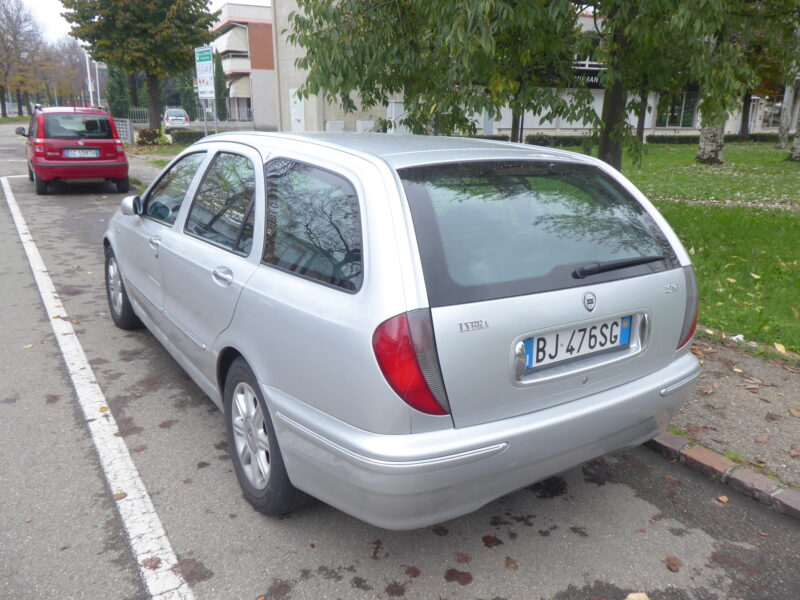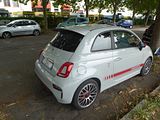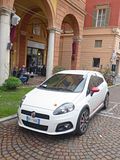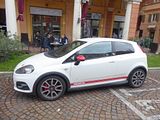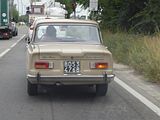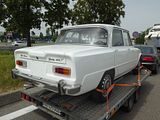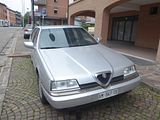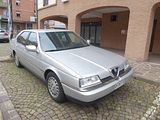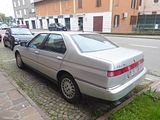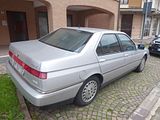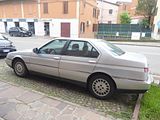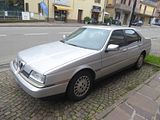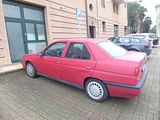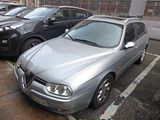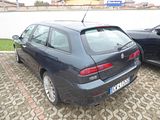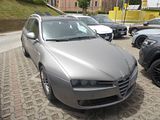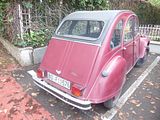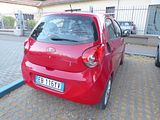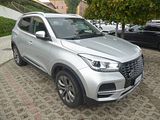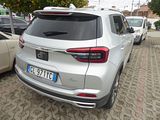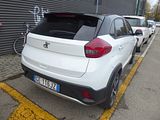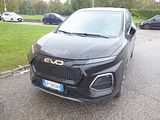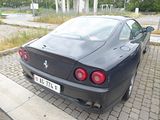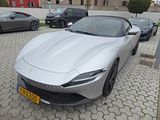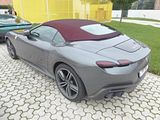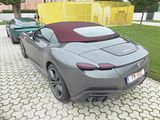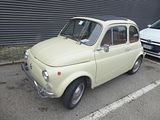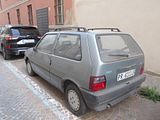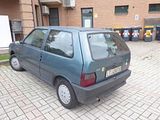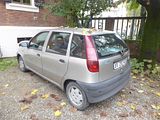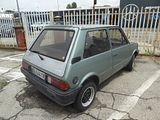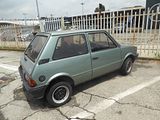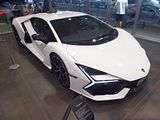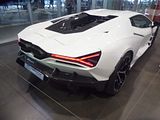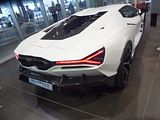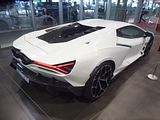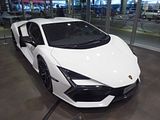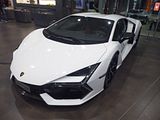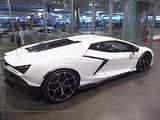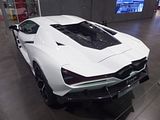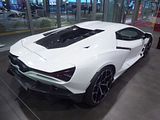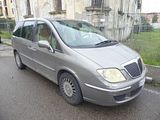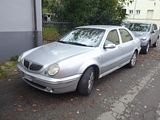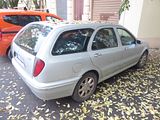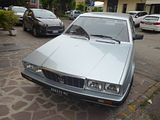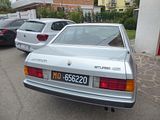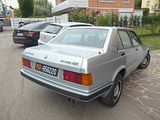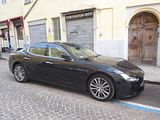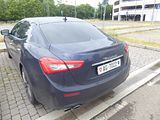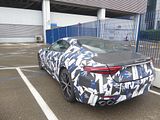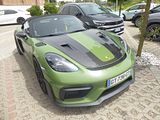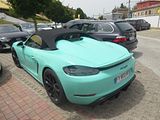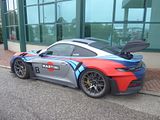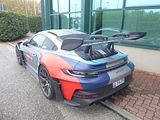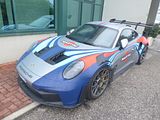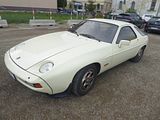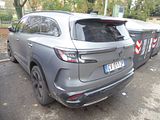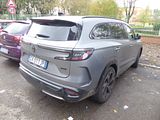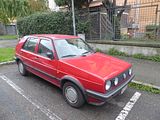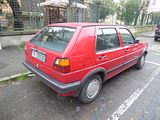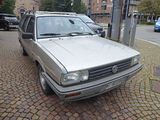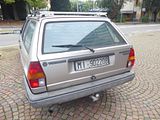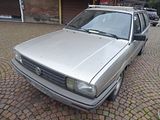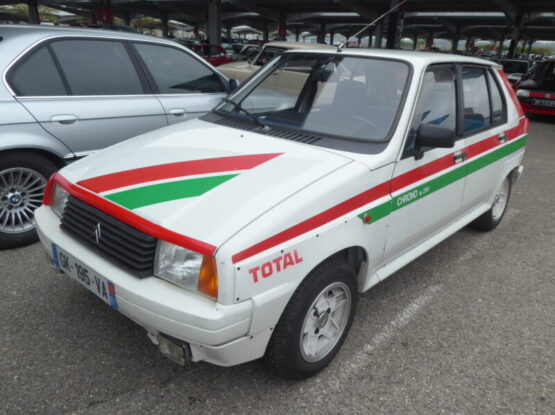Although the car markets of the world have globalised like never before, there are still plenty of cars which have been offered in countries even relatively close to home that were never sold here in the UK. And even where a model was offered, different sales preferences and innate survival rates mean that you can see quite a lot of cars out and about and parked up on the roads of another country that are noteworthy, and to my mind, always worth a photo when that is possible. Of course, often it is not possible, as the car is moving, and if you yourself are also driving, then there is a fleeting glimpse but that is it. But when walking about, in tourist mode, photos do become possible and so over the years I have published a number of posts like this one which summarise a miscellaneous collection of cars that I spotted when actually focused on something else, usually tourist sight-seeing mode. The cars in this report were spotted on a couple of separate trips to Italy in 2024. The first, in June, was a few days which encompassed arrival at Bologna airport and then journeys to Modena, Torino, Parma and back to Bologna. The second was my autumn visit to the Auto e Moto d’Epoca event in Bologna, so also started at Bologna airport, but did include time in Modena and south of the Apennines in San Gimignano. There is a mixture of a few supercars, some now rare everyday cars and few more or less new models which are ones you would not see in the UK.
ABARTH
Not surprisingly, Italy is an important market for Abarth and some months it has been the one buying most new examples, globally. And yet, I rarely see that many on the roads here, certainly even fewer than you see in the UK. There were a few that I was able to catch on camera this time:
What is known as the Series 4 version of the familiar 595 reached the markets in the middle of 2016. After rumours had circulated all winter following the launch of the facelifted Fiat 500 last year, Abarth finally unveiled the Series 4 at the end of May 2016. Initially, we were told that the cars would not be available in the UK until September, but that came forward somewhat, with dealers all receiving demo cars in June, and the first customers taking delivery in July. Three regular production versions of both the closed car and the open-topped C were initially available, all badged 595, and called Custom, Turismo and Competizione, as before, though numerous limited edition models have since appeared and in most case disappeared. The most significant changes with the Series 4 are visual, with a couple of new colours, including the much asked for Modena Yellow and a different red, called Abarth Red, which replaces both the non-metallic Officina and – slightly surprisingly – the tri-coat pearlescent Cordolo Red. as well as styling changes front and rear. The jury is still out on these, with many, me included, remaining to be convinced. At the front, the new air intake does apparently allow around 15 – 20 % more air in and out, which will be welcome, as these cars do generate quite a lot of heat under the bonnet. Competizione models for the UK retain the old style headlights, as they have Xenon lights as standard, whereas the Custom and Turismo cars have reshaped units. At the back, there are new light clusters and a new rear bumper and diffuser. Inside, the most notable change is the replacement of the Blue & Me system with a more modern uConnect Audio set up, which brings a new colour screen to the dash. Mechanically, there is an additional 5 bhp on the Custom (now 145) and Turismo (now 165 bhp) and the option of a Limited Slip Diff for the Competizione, which is likely to prove a popular option. Details of the interior trim have changed, with a filled-in glovebox like the US market cars have always had, and electric windows switches that are like the US ones, as well as a part Alcantara trim to the steering wheel in Competizione cars.
The Abarth Grande Punto debuted at the 2007 Frankfurt IAA Show, going on sale in the UK in late summer of 2008. Offering 155 bhp from its 1.4 litre T-Jet engine, coupled to a six speed gearbox, and riding on 45 profile 17″ alloys, the standard car got rave reviews from the journalists when they first tried it, and they were even more impressed by the changes wrought by the optional Esseesse kit. This increased power to 177 bhp, brought 18″ OZ lower profile wheels, whilst new springs lowered the ride height by 15-20mm, and high-performance front brake pads and cross-drilled front disc brakes helped the car to stop more quickly. The most distinctive feature of the car were the white alloy wheels, though, as owners found, keeping these clean is not a job for the uncommitted, and many have a second set of wheels that they use fro grubbier conditions. Despite the positive press at launch, the car entered a very competitive sector of the market, and the combination of being relatively unknown, a limited number of dealers and the existence of established rivals from Renault and others meant that this always remained a left-field choice. The owners loved them, though, and they still do. The oldest cars have now had their 15th birthdays, and some have amassed relatively big mileages, but they are still a car for the cognoscenti.
ALFA ROMEO
First of the all-new Giulia models to appear was the Berlina, launched in 1962. The styling was quite straight forward, but great attention was paid to detail. The engine bay, cabin and boot were all square shaped. But the grille, the rooflines and details on the bonnet and boot made for an integrated design from bumper to bumper. Thanks to Alfa Romeo using a wind tunnel during its development, the Giulia was very aerodynamic with a drag coefficient of Cd=0.34, which was particularly low for a saloon of the era and not a bad figure even for cars of today. Couple that with the fact that Alfa Romeo was one of the first manufacturers to put a powerful engine in a light-weight car (it weighed about 1,000 kilograms) and thanks to an array of light alloy twin overhead camshaft four-cylinder engine, similar to that of the earlier Giulietta models range, the car had a lively performance which bettered that of many sports cars of the day. The Tipo 105.14 was the first model, with a 1,570 cc Twin Cam engine with single down-draft carburettor generating 91 hp at 6500 rpm. The “TI” nomenclature referred to a class of Italian saloon car racing known as “Turismo Internazionale”, and had previously been applied to higher-performance versions of the 1900 and Giulietta saloons in the 1950s. However, for the Giulia saloon, the Ti was at first the only version available, and later, with the introduction of the TI Super and Super, the TI became the base version for the 1,600 cc engine class. The steering column gearchange (the only one in the Giulia range) was replaced with a floor change for 1964 (Tipo 105.08). Right hand drive cars, available from 1964, only ever had a floor change (Tipo 105.09). Brakes were by drums all around at first. Discs were introduced later, first at the front, and later all around. A brake servo was not fitted at first, but was introduced in later cars. The steering wheel featured the only horn ring ever in the Giulia range. The dashboard with a strip speedo is a notable feature, as is the steering wheel with a horn ring. The Giulia TI was phased out in 1968 and re-introduced as the austerity model 1600 S. Tipo 105.16 was a special racing model introduced in 1963. Quadrifoglio Verde stickers on the front wings were a distinguishing feature. Only 501 were made for homologation and today it is very rare and desirable. The 1,570 cc engine was fitted with two double-choke horizontal Weber 45DCOE carburettors for 110 hp at 6500 rpm. The body was lightened and a floor gearchange was fitted as standard, as were alloy wheels of very similar appearance to the standard steel ones of the TI. The TI’s instrument cluster with its strip speedometer was replaced with a three-instrument binnacle comprising speedometer, tachometer and a multi-gauge instrument (fuel, water temperature, oil temperature and pressure) – these instruments were similar to those fitted to the contemporary Giulia Sprint and Sprint Speciale coupes and Spider convertibles. The steering wheel was a three-spoke item with centre hornpush, also similar to that of the more sporting models. Braking was by discs all around, although the first cars used drums and early disc models lacked a servo which was introduced later. The police cars seen in The Italian Job were of this type. Tipo 105.06 was an austerity model made from 1964 to 1970 with a 1,290 cc single-carburettor engine for 77 hp at 6000 rpm. Four-speed gearbox with floor change fitted as standard (the 1300 was the only Giulia model not fitted with a five-speed gearbox). Though the engine was given a 105 series type number, it was basically the engine from the 101 series Giulietta Ti. This model appears not to have been exported to many markets outside Italy, if at all. Braking was by discs all around, without a servo at first, later with a servo. Tipo 105.26 was introduced in 1965. It transferred the technology from the racing TI Super to a road car, to make the most successful Giulia saloon. 1,570 cc engine with two double-choke Weber 40DCOE carburettors for a milder, but torquier tune than the TI Super – 97 hp at 5500 rpm. There was a new dashboard with two large round instruments (speedo and tacho) and clock, a sportier steering wheel with three aluminium spokes and centre horn push, similar to that of the Ti Super, later changed for one with the horn pushes in the spokes. All-around disc brakes with servo were fitted as standard from the outset. The serpent crest of the Sforza family appears in a badge on the C-pillar and is a distinguishing feature of the Super. For 1968, there was a suspension update, including revised geometry and a rear anti-roll bar. The wheels were changed in size from 5J x 15 to 5J x 14, and tyres from 155/15 to 165/14. For 1970, updates included dual-circuit brakes, centre-mounted handbrake lever to replace under-dash “umbrella handle”, larger external doorhandles, and top-hinged pedals (the latter in left hand drive models only; right hand drive continued with bottom-hinged pedals to the end of production). In 1972, Tipo 105.26 was rationalised into the Giulia 1.3 – Giulia 1.6 range. Tipo 105.39 built from 1965 to 1972. Right hand drive model replaced in 1970 by the 1300 Super. 1,290 cc engine with single down-draft carburettor for 81 hp at 6000 rpm. Unlike the re-deployed 101-series Giulietta engine of the austerity-model 1300, the 1300 ti motor was a 105 series engine, basically that of the sportier GT1300 Junior coupe with different camshaft timing (but the same camshafts) and induction system. Five-speed gearbox. Three-spoke bakelite steering wheel with plastic horn push covering the centre and spokes. Dashboard initially with strip speedo like that of the TI. For 1968, updates included a dashboard based on that of the Super, but with a simpler instrument binnacle, still featuring two large round instruments (speedo and tacho) and a separate fuel gauge, and the same suspension, wheel and tire updates applied to the Giulia Super in the same year. For 1970, updates included dual-circuit brakes, centre handbrake, larger external doorhandles and top-hinged pedals (on left hand drive cars only), again as applied to the Super for that year. Tipo 105.85 was basically a Giulia TI re-introduced in 1968 as a lower-level model to come between the 1300 and 1300 ti on one hand, and the Super on the other. It had a re-interpretation of the 1,570 cc single-carburettor engine for 94 hp at 5500 rpm and similar trim to the 1300 ti. Replaced in 1970 by the 1300 Super which offered similar performance in a lower tax bracket. The last cars from 1970 featured the top-hinged pedals, centre handbrake and dual-circuit brakes as for the Super and 1300 ti. Tipo 115.09 was introduced in 1970. It was basically a 1300 ti fitted with the engine from the GT 1300 Junior coupe that featured two double-choke horizontal carburettors; the engine actually had the GT 1300 Junior type number. This model was rationalised into the Giulia Super 1.3 – Giulia Super 1.6 range in 1972. In 1972 a rationalisation of the Giulia range saw the Super 1300 (Tipo 115.09) and the Super (Tipo 105.26) re-released as the Super 1.3 and Super 1.6. The two models featured the same equipment, interior and exterior trim, differing only in engine size and final drive ratio. The 1300 ti was dropped. A small Alfa Romeo badge on the C-pillar is a distinguishing feature, as are hubcaps with exposed wheel nuts. In December 1972 Alfa-Romeo South Africa released the 1600 Rallye. This locally developed more powerful 1600 cc version of the 1300 Super used the 1300’s single-headlight body shell. The car was largely ready for competition and was only planned to be built in limited numbers, and was fitted with racing-style rear-view mirrors, rally lamps, fully adjustable seats, and a limited-slip differential. Claimed power was 125 hp. The Giulia Super range was re-released in 1974 as the Nuova Super range, including the Giulia Nuova Super 1300 and 1600 This featured a new black plastic front grille and a flat boot lid without the characteristic centre spine. Otherwise the cars differed little from their Giulia Super predecessors and bore the same Tipo numbers with an S suffix. A Nuova Super fitted with a Perkins 1,760 cc diesel with 54 hp at 4000 rpm, was the firm’s first attempt at diesel power. The same Perkins diesel was used also in Alfa Romeo F12 van. The diesel version was slow, 138 km/h (86 mph), and the engine somehow unsuitable for a sport sedan so it was not big seller, only around 6500 examples were made in 1976 and the car was not sold in the UK. Production of the Giulia ceased in 1977.
Even in Italy, the 164 is pretty rare now. I spotted this one in the centre of Maranello and was able to park up just up the road so I could walk back and grab these photos. The 164 remains one of my favourite cars and I had the pleasure of driving one for 4 years and 160,000 miles and to this day, it is the car I regret parting with more than any other of the fleet that I have owned over the years. When I bought mine, Alfa were selling a very small number of cars per month in the UK, so they were never that common, and sadly, survival rates are very low. Most people who know anything about the history of the 164 will be aware that this is one of the four so-called Type 4 cars, a joint venture involving Alfa Romeo, Fiat, Lancia and Saab. In 1978 these four marques agreed to each develop an executive saloon based on a shared platform to compete against the likes of the Ford Granada and Opel Rekord (Vauxhall Carlton) as well as more premium saloons by BMW and Mercedes-Benz in the form of the 5-Series and E-Class, respectively. Alfa’s Project 164 started life as Project 154 and was completed in 1981, then still under Alfa Romeo. A year later, that project morphed into the 164 based on the Type Four platform. This new model was designed by Enrico Fumia of Pininfarina, with a wedge shape that afforded it a leading drag coefficient of Cd=0.30. The design would later influence the rest of the Alfa Romeo range starting in 1990 with the major redesign of the 33 and culminating with the 155, and Pininfarina also adapted it (much to the maker’s chagrin) for the 1987 Peugeot 405 and the 1989 Peugeot 605 saloons. Initial testing of the 164’s dynamic elements (engine and drivetrain) began in 1984, where mules based on the then contemporary Giulietta were used. In 1985, the first pre-production 164’s were put through their paces on the road. Heavily disguised, with many false panels and even a false nose design (borrowing heavily from the then equally undeveloped 155), sporting 4 round headlamps, these vehicle mules served to test the 164 for the gruelling 1 million kilometre static and road testing demanded of the design. In 1986 and 1987, the first 150 164’s were given their pre-production testing. In terms of engineering demands, these exceeded every Alfa before, and by quite a substantial margin. In Morocco, desert testing saw 5 grey 164 Twinsparks and V6’s undergo the equivalent of the Paris-Dakar rally. Road conditions varied from good tarmac to off-road conditions, and accelerometers confirmed the superiority of the 164 in terms of passenger comfort. This data was cross-confirmed in the engineering laboratory with a sophisticated dummy in the driver’s seat, with accelerometers both in its seat, and in its ears to mimic that of the semi-circular canals of the ear. The Twinspark and the V6 underwent handling trials at Arese. The Twinspark displayed very mature driving manners at the limit, with minimal skid. The V6 displayed a 25% increase in at-the-limit skid, a natural consequence of its greater nose weight. ABS testing confirmed that the Twinspark has superior braking to the V6. Brake linings of the 164’s were run at maximum braking until they literally glowed with heat, and displayed no deviation in form. The 164 was the first Alfa to feature slotted double-walled disc brakes. At no point were the discs drilled to release excess heat, the original design being demonstrated to be excellent. Sound production was tested in an anechoic chamber, the car being subjected to stress and road noise testing, with instruments and with live subjects at the wheel, on a specially designed rig. Electromagnetic stability of the complex electronic system was also tested, in an anechoic chamber equipped with EM emitters (radar). The 164 engines were run to destruction, the Twinspark proving to be the most robust, and with the longest possible engine life. The V6 displayed only 10% shorter overall engine life. All this testing meant that by the time the production car, called the 164 was unveiled at the 1987 Frankfurt Motor Show – the last model to be developed while the Alfa Romeo was still a fully independent company, even though the launch was a few months after the takeover by Fiat – that the car was far more thoroughly developed and tested than any Alfa preceding it. There were plenty of innovations in the build, too, thanks to the extensive use of galvanised steel for the frame and various body panels for the first time in the brand’s history. Moreover, the car featured advanced electronics thanks to the most complex wiring harness fitted to any Alfa Romeo. For example: it had three onboard computers (one for air conditioning, one for instrumentation, and one for the engine management); air conditioning and instrument functions shared a multiple-mode coded Zilog Z80-class microcontroller for dashboard functioning). The instrumentation included a full range of gauges including an advanced check-panel.. The car was a sensation at launch. For a start, it looked fantastic thanks to Enrico Fumia of Pininfarina’ design. The first 1:1 scale model of the car had been produced in 1982 and design cues had been publicly revealed on the Alfa Romeo Vivace concept car, which was exhibited at the 1986 Turin Motorshow that went on to influence the design of the Alfa Romeo GTV and Spider (916 series) launched in 1993, but the result was distinctive and elegant and very different from any of its rivals, or indeed any of the other Tipo 4 cars. The 164 became the first Alfa to benefit from extensive use of computer aided design, used to calculate structural stresses that resulted in a very rigid but still relatively lightweight chassis. Although sharing the same platform as that of the Lancia Thema, Fiat Croma and Saab 9000, by virtue of the fact that it was the last of the four to enter production, it featured unique front suspension geometry and the most distinctive styling of the lot. In fact, for example, the other cars all shared identical side door panels. Though still voluminous, the 164 had the tightest aperture to the boot, which had a 510-Litre capacity. The interior was spacious and modern, available with standard velour seating or leather trim depending on the model. Its dashboard continued the avantgarde design of the exterior with a centre dashboard that was dominated by a large number of seemingly identical buttons arranged in rows. Air-direction within the ventilation system was controlled by a pair of servomechanisms, which were constructed using notoriously fragile plastic gears that were prone to failure. Depending on the model, the 164 could feature automatic climate control and electronically controlled damping suspension – the latter, for example, in the sports-oriented Quadrifoglio Verde (“Green Cloverleaf “) and 164S models. This suspension actively reduced damping in response to conditions to provide a dynamic compromise between road holding and comfort. At launch, the original 164 range comprised three models: a 148 bhp 2.0 Twin Spark, the 192 bhp 3.0i V6 12-valve and a 2.5 Turbodiesel (badged “TD”). It took a year before the first cars reached the UK and the first eighteen months saw only the 3 litre model offered. The bigger selling 2.0 TS arrived in the simmer of 1990, just before the range was expanded by the 4-cylinder 2.0i Turbo, the sports-oriented 3.0i V6 Quadrifoglio Verde (badged “QV” or “S”) and North American export versions that included the luxury-oriented 164 L (“L” for Lusso) and the 164 S (in essence, the “QV”). Apart from minor running production upgrades, the next change came in 1993 with the launch of the 164 Super. Key differences on the outside consisted of larger bumpers with chrome trimmings added to the upper edge and revised headlights with a slimmer profile. Inside, there were revised instruments and a centre console that featured more delineated switchgear. The range was now also bolstered by a 3.0 V6 24V with a 24-valve engine upgrade and the 3.0 V6 Quadrifoglio 4 (badged “Q4”), which was the most powerful and sole all wheel drive variant built. Production ended in late 1997, with a gap of nearly two years before the replacement model would go on sale.
The 155 was one of a series of cars built by the Fiat Group on a shared platform, the so called Tipo 3 or Tipo Tre, which sat under the Fiat Tipo, and Lancia Delta 2, as well as the Fiat Coupe. Built to replace the rear wheel drive 75, the 155 was somewhat larger in dimension than its predecessor. The 155 was designed by Italian design house I.DE.A Institute which achieved an exceptional drag coefficient of 0.29, and the rather boxy design gave the car a sizeable boot, as well. The single most significant technical change from the 75 was the change to a front-wheel drive layout. This new configuration gave cost and packaging benefits but many Alfa die-hards and the automotive press lamented the passing of the “purer” rear-wheel drive layout on a car from this sporting marque. Not even the availability of the 155 Q4, which had a 2.0-litre turbocharged engine and a permanent four-wheel drive powertrain, both derived from the Lancia Delta Integrale; making the car essentially a Lancia Delta Integrale with a different body was enough to win the sceptics over. Reception of the model was generally lukewarm. The 75 had been conceived prior to Fiat’s acquisition of the Alfa brand, so as “the last real Alfa” it cast rather a shadow over the 155; the loss of rear-wheel drive was frequently cited as the main cause of the disappointment. Nevertheless, the 155 was entered in Touring Car racing and was successful in every major championship it entered, which gradually improved its image. Belatedly, the factory introduced a wider version in 1995 (the “wide-body”) which as well as a wider track and revised steering based on racing experience or requirements, also brought in new 16-valve engines for the 1.8 and 2.0-litre whilst retaining the 2.5 V6 and making some improvements to cabin materials and build quality. There were several Sport Packs available, including a race-inspired body kit (spoiler and side skirts) and black or graphite-coloured 16-inch Speedline wheels. The more genteel could opt for the Super which came with wood inserts in the cabin and silver-painted alloy wheels. With this version, the 155 really came good. When production ceased in 1998, following the launch of the 156, 192,618 examples had been built.
A significant addition to the 156 range came in 2000 with the introduction of the Sportwagon station wagon or estate bodystyle, debuting at the Geneva Motor Show. The new bodystyle was in development from 1998 by Stola under the project code ‘932 AF’. According to Stola’s records the initial considered name was “Powerwagon”. While not a core part of the company’s range, estate versions of the Alfasud and 33 – the first to carry the name Sportwagon – were produced and a 75 Sportwagon was shown at Geneva, but became an early victim of the Fiat takeover. The Sportwagon was also available with Boge-Nivomat self-levelling hydropneumatic rear suspension. The Sportwagon was marketed as a lifestyle estate without large carrying capacity. The Sportwagon bodystyle filled a gap in the market that Alfa Romeo had distanced themselves from since the 33 SportWagon of the 1980s.
Alfa followed the 156 a couple of years later, in late 1998, with a larger saloon, the 166, hoping to receive the same sort of acclaim with this executive car which was a direct replacement for the 164. It was not forthcoming. For a start, the styling with its drooping and very small headlamps and pointed nose was quite unlike anything else on the market at the time. Part of the difficulty came from the fat that the car had been designed some years before its launch and then put on the back burner as the 156 was given priority. The 166 was initially available with a 155 PS 2.0-litre Twin Spark, a 190 PS 2.5 V6, a 220 PS 3.0 V6 and in some markets a 205 PS V6 2.0 Turbo petrol engine along with a diesel powered L5 2.4 10v common rail turbodiesel version with 136 PS, 140 PS and 150 PS (148 hp) output. The 2.0 TS model used a 5-speed manual gearbox, whilst the 2.5 and 3.0 had the option of a Sportronic automatic gearbox. The 3.0 V6, L5 2.4 and V6 Turbo were otherwise supplied with a six-speed manual gearbox. The top models were named “Super”, and included MOMO leather interior, 17″ alloy wheels, rain sensitive wipers, cruise control, climate control and ICS (Integrated Control System) with colour screen. Options included xenon headlamps, GSM connectivity and satellite navigation. Suspension systems comprised double wishbones at the front and a multi-link setup for the rear. Though the car’s handling characteristics, engine range and elegant exterior design received praise from many, including Top Gear’s Jeremy Clarkson, it did not become a strong seller to rival the dominant German brands, in the European executive car sector. In September 2003, the 166 underwent a substantial revamp, with the début at the Frankfurt Motor Show. As well as upgrades to the chassis, interior, and the engine range, the styling was substantially altered. The new front end resembled the also recently revamped 156, and lost its famous drooping headlights. The 2.0 V6 Turbo model was dropped because of marketing problems, the V6 2.5 was re-rated at 188 PS and a 3.2 litre V6 with 240 PS was introduced. Both the 3.2 litre and the 2.0 Twin Spark models now featured the six-speed manual gearbox, whilst the 3.0 model was retained, but made available only in Sportronic form. In the diesel sector, the L5 2.4 was re-engineered with Multi-Jet technology which allows up to 5 injections per cycle, second stage common rail, with maximum injection pressure of 1400 bar and 4 valves per cylinder, to output a class leading 175 PS, but these changes made little impact on sales volumes. In October 2005, the Alfa Romeo 166 was officially withdrawn from sale in markets for RHD. Sales of the 166 never grew as Alfa had hoped, following the facelift in September 2003, and the additional lack of a diesel engine in the United Kingdom, Australian, and Irish markets limited its reach into company car sectors. In June 2007, production of the 166 effectively ended, with no direct successor. In September 2008, the platform was sold to the Chinese state run manufacturer GAC Group. In total, less than 100,000 units were made.
Replacement for the much loved 156 was the 159. The Alfa Romeo 159 had a troubled development, being designed in the midst of the Fiat-General Motors joint venture which was terminated in 2005. Originally, the 159 was intended to use GM’s Epsilon platform; however, late during its development it was changed to the GM/Fiat Premium platform. The Premium platform was more refined and expensive, being intended for E-segment executive cars such as an Alfa Romeo 166 successor but that never materialised, so Alfa Romeo attempted to recoup some of the platform development costs with the 159. General Motors originally planned Cadillac, Buick and Saab models for this platform but ending up discarded them over cost concerns. Unfortunately, the 159’s late transition to what was fundamentally made as an E-segment platform resulted in the 159 having excessive weight, a problem shared by its sisters, the Alfa Romeo Brera coupe and Spider convertible. The 159 was designed by Giorgetto Giugiaro in collaboration with the Centro Stile Alfa Romeo. The nose featured a traditional Alfa Romeo V-shaped grille and bonnet, and cylindrical head light clusters. Similar to its coupé counterpart, front of the car was influenced by the Giugiaro designed 2002 Brera Concept. Several exterior design cues were intended to make the car appear larger, supposedly to appeal to potential buyers in the United States; however, the 159 was never exported to that region. The interior featured styling treatments familiar from earlier cars, including the 156, such as deeply recessed instruments which are angled towards the driver. Alfa Romeo intended for the 159 to compete more directly with BMW, Mercedes-Benz and Audi by using higher quality interior materials; however, it has been said that Alfa Romeo misjudged their brand’s positioning relative to the more well-known German luxury automakers. Several levels of trim were available, depending on market. Four trim levels: Progression, Distinctive, Exclusive and Turismo Internazionale (TI) featured across Europe. In the UK there were three levels of trim: Turismo, Lusso and Turismo Internazionale (TI). A Sportwagon variant was introduced at the Geneva Motor Show in 2006. The 159’s size made it considerably more comfortable than the 156 due to its larger, roomy interior. However, the considerable growth in dimensions deterred many 156 owners from considering the 159 as a direct replacement model, and something seemed to be lost in the character of the new car. Initially offered with a choice of 1.9 and 2,2 litre 4 cylinder and 3.2 litre V6 petrol engines and 1.9 and 2.4 litre diesel units, and an optional four wheel drive system. An automatic gearbox option for the 2.4 JTDM diesel model was also launched in late 2006, and later extended to other versions. In 2007 a four-wheel drive diesel model was released and the 2.4-litre diesel engines’ power output increased to 210 hp, with a newly reintroduced TI trim level also available as an option. For model year 2008 the mechanics and interiors of the 159 were further developed. The 3.2 litre V6 model was offered in front wheel drive configuration, achieving a top speed of 160 mph. All model variants came with Alfa’s electronic “Q2” limited slip differential. As a result of newly introduced aluminium components, a 45 kilograms (99 lb) weight reduction was achieved. For 2009, Alfa introduced a new turbocharged petrol engine badged as “TBi”. This 1742 cc unit had direct injection and variable valve timing in both inlet and exhaust cams. This new engine had 200 PS (197 hp) and would eventually replace the GM-derived 2.2 and 1.9 JTS units.In 2010, all petrol engines except for the 1750 TBi were retired, ending the use of General Motors-based engines in the 159. The only remaining diesel engines were the 136 PS and 170 PS 2.0 JTDm engines. In 2011, the 159 was powered only by diesel engines. In the UK, Alfa Romeo stopped taking orders for the 159 on 8 July 2011. Production for all markets ceased at the end of 2011, after 240,000 had been built.
ASTON MARTIN
The Aston Martin DB11 is a two-door grand touring car. It was available as both a coupe and a convertible, the latter known as the “Volante”. The British carmaker Aston Martin produced the DB11 from 2016 to 2023 when it was replaced by the DB12. The DB11 succeeded the DB9, which the company made between 2004 and 2016. Designed by Marek Reichman, who became lead designer in May 2005, the DB11 debuted at the Geneva Motor Show in March 2016. The first model of Aston Martin’s “second-century plan”, the DB11—like its predecessor and its platform siblings—incorporates aluminium extensively throughout its body. Official manufacture of the DB11 began at the facility in Gaydon, Warwickshire, in September 2016. Two engine configurations of the DB11 were available: a 4.0-litre V8-engine model produced by Mercedes-AMG and a 5.2-litre V12-engine model produced by Aston Martin. The Volante version of the DB11 was introduced in October 2017. In 2018, Aston Martin and its racing division replaced the DB11 V12 with the DB11 V12 AMR, which included an increased engine output. The V8-powered model also received an enhancement in engine performance in 2021. Aston Martin began producing the DB9—a grand touring car—in January 2004 at the facility in Gaydon, Warwickshire. It was the first car built on the vertical–horizontal platform—a design in which all vehicles that used it extensively incorporated aluminium throughout their construction. This platform formed the basis of the Vantage in 2005, the DBS in 2007, the Rapide in 2010, the Vanquish in 2012 and the Lagonda Taraf in 2014. In 2015, Aston Martin announced that the DB9’s successor would be named the “DB11”. The upcoming range, known as the “second-century plan”, which the DB11 was a part of, was to introduce a refreshed design approach directed by Marek Reichman, whom Aston Martin appointed lead designer in May 2005. Insider reports indicated that this model range aimed to address critiques of the existing lineup by emphasising distinctive differences among the models, aligning them more closely with the prominent Italian luxury automobile manufacturer Ferrari. Manufacture of the DB9 officially ended in July 2016, after a twelve-year production run during which 16,500 units had been made. The DB11 debuted at the Geneva Motor Show in March 2016. Official manufacture of the DB11 began on 28 September 2016 at the facility in Gaydon, Warwickshire. To demonstrate his commitment to quality, Aston Martin’s then-CEO, Andy Palmer, personally inspected the first 1,000 cars. Similar to its predecessor, the DB11 is based upon a platform—which it shares with the 2018 model Vantage and the DBS Superleggera—that extensively incorporates aluminium throughout its construction. The chassis, in comparison to the DB9, is lighter and stiffer. Its body panels are made of both aluminium and composite materials, and the bonnet is a single-piece unit. Together, the car’s flat underbody, rear diffuser and sizable front splitter manage airflow beneath the DB11, minimising lift. The DB11 features an AeroBlade that captures high-speed air at the C-pillars and channels it through ducts under the bodywork, exiting through slots in the boot lid. This system mimics the effects of a large rear spoiler, reducing drag without added bodywork. An extendable active spoiler enhances the AeroBlade’s efficiency at high speeds. The DB11 has been described as both a sports car and a grand tourer. It is a two-door coupe that was available only in a four-passenger seating configuration. The DB11 has a rear-wheel drive layout with a front-mid-engine placement and exclusively uses a rear-mounted, eight-speed automatic transmission made by the technology manufacturing company ZF Friedrichshafen. Each DB11 was handcrafted, involving approximately 600 engineers and taking around 250 hours to complete. The Vanquish features anti-roll bars and double wishbone suspension supported by coil springs. There are three different drive modes available for both the drivetrain and chassis: normal—suitable for daily driving; sport—offering enhanced precision; and Sport+—intensifying the characteristics of the sport mode. The DB11 has a near-perfect weight distribution of 51 per cent at the front and 49 per cent at the rear. According to the magazine Motor Trend, the DB11 has a combined fuel economy figure of 17 miles per US gallon (14 L/100 km; 20 mpg‑imp). According to Auto Express, the car has a CO2 emission rating of 270 g/km. The doors of the DB11, like the DB9, are swan-hinged. The infotainment system operates on an eight-inch liquid-crystal display accessed via a rotary controller or an optional touchpad. Each DB11 comes with a 400-watt audio system, USB playback, SiriusXM satellite radio, and a Wi-Fi hotspot with iPhone integration. Upgrades were available for a 700-watt sound system or a 1,000-watt Bang & Olufsen unit. The DB11 has a boot capacity of 270 litres (9.5 cu ft). The AE31 twin-turbocharged V12 engine, with a 5,204 cc displacement, was featured in the initial version of the DB11. It produces a power output of 600 bhp at 6,500 rpm and a torque output of 700 Nm (520 lb/ft) between 1,500–5,000 rpm, sufficient to give the car a zero to 60 mph (97 km/h) acceleration of 3.6 seconds and a maximum speed of 200 miles per hour (320 km/h). Aston Martin began the development of the V12 engine in the summer of 2012 under the leadership of Brian Fitzsimons. The project progressed quickly; initial test firing began in October 2012, and it received approval for production in January 2013. The new V12 engine continues to use conventional fuel injection rather than direct injection due to concerns about the potential increase in particulate emissions associated with direct injection petrol engines. The DB11 V12 can run the quarter mile in 11.7 seconds. In May 2018, Aston Martin introduced the DB11 Aston Martin Racing (AMR) version, which succeeded the DB11 V12. The DB11 AMR offers enhanced performance capabilities compared to its predecessor. The previous DB11 V12 had been in production for eighteen months. The updated DB11 AMR produces a power output of 630 bhp at 6,500 rpm and a torque output of 700 Nm (520 lb/ft) at 1,500 rpm, sufficient to give the car a zero to 60 mph (97 km/h) acceleration of 3.7 seconds and a maximum speed of 208 mph (335 km/h). Its shift programming has been revised, its rear suspension is firmer and stiffer, and its twenty-inch forged wheels are 3.5 kilograms (7.7 lb) lighter. Aston Martin introduced a limited edition of 100 DB11 AMR Signature Edition cars at the beginning of production, featuring a Stirling Green paint scheme with lime green accents. It has a zero to 60 mph (97 km/h) acceleration of 3.5 seconds—0.2 seconds faster than the base AMR. Deliveries started in the second quarter of 2018. In July 2021, Aston Martin announced that the AMR name would no longer be used for the V12-powered DB11 as part of their updated model lineup. The original V12 model was supplemented by an entry-level V8 version in June 2017. Powered by a 4.0-litre Mercedes-Benz M177 twin-turbocharged V8 engine developed by Mercedes-AMG, this configuration achieves a weight reduction of 115 kilograms (254 lb) compared to the V12 variant, resulting in a total kerb weight of 1,760 kilograms (3,880 lb). In contrast to the V12 model, the DB11 V8 has a weight distribution of 49 per cent at the front and 51 per cent at the rear. The V8 engine delivers 503 bhp and 675 Nm (498 lb/ft), providing the car with a zero to 60 mph (97 km/h) in four seconds and a top speed of 187 mph (301 km/h). In July 2021, Aston Martin revealed an upgraded version of the DB11 V8. The power output was increased to 528 bhp, allowing the car to accelerate from zero to 60 mph (97 km/h) in 3.9 seconds and reach a higher top speed of 192 miles per hour (309 km/h). In October 2017, Aston Martin introduced the DB11 Volante, a convertible version of the DB11. The Volante has a weight distribution of 47 per cent at the front and 53 per cent at the rear, and is powered by the same 4.0-litre twin-turbocharged V8 engine as the DB11 V8 coupe, albeit with more torque, at 696 Nm (513 lb/ft). The DB11 Volante can accelerate from zero to 60 mph (97 km/h) in 4.1 seconds and possesses a maximum speed of 187 mph (301 km/h). The additional lower body strengthening and the electric roof mechanism in this version increase the weight by approximately 110 kilograms (240 lb). The DB11 received mostly positive reviews. Production of the DB11 ended at the end of June 2023. It was replaced by the DB12, which was unveiled at the 2023 Cannes Film Festival.
BMW
One of a number of cars parked up at the Ferrari museum in Modena was this, the latest M4.
CITROEN
There is a long history to this car, but it was only really with the relaunch of the model to the UK market in 1974 when interest here took off. Sales of the 2CV were reinvigorated by the 1974 oil crisis. The 2CV after this time became as much a youth lifestyle statement as a basic functional form of transport. This renewed popularity was encouraged by the Citroën “Raid” intercontinental endurance rallies of the 1970s where customers could participate by buying a new 2CV, fitted with a “P.O.” kit (Pays d’Outre-mer—overseas countries), to cope with thousands of miles of very poor or off-road routes. Because of new emission standards, in 1975 power was reduced from 28 hp to 25 hp. The round headlights were replaced by square ones, adjustable in height. A new plastic grille was fitted. In July 1975, a base model called the 2CV Spécial was introduced with the 435 cc engine. Between 1975 and 1990 under the name of AZKB “2CV Spécial” a drastically reduced trim basic version was sold, at first only in yellow and with an untreated black roof. Slimmer bumpers with stick-on tape rather than plastic strips and no overriders were fitted. It also had the earlier round headlights, last fitted in 1974. In order to keep the price as low as possible, Citroën removed the third side window, the ashtray, and virtually all trim from the car, while that which remained was greatly simplified, such as simple vinyl-clad door cards and exposed door catches rather than the plastic moulded trims found on the 2CV Club. Other 2CVs shared their instruments with the Dyane and H-Van but the Spécial had a much smaller square speedometer also incorporating the fuel gauge, originally fitted to the 2CV in the mid-1960s and then discontinued. The model also had a revised (and cheaper-to-make) plastic version of the 1960s two-spoke steering wheel instead of the one-spoke item from the Dyane, as found on the Club. From the 1978 Paris Motor Show the Spécial regained third side windows, and was available in red and white; beginning in mid-1979 the 602 cc engine was installed. In June 1981 the Spécial E arrived; this model had a standard centrifugal clutch and particularly low urban fuel consumption. By 1980 the boost to 2CV sales across Europe delivered by the 1973 Energy Crisis had begun to wear off and there was a whole new generation of superminis and economy cars available from European and Japanese manufacturers. Citroën itself now had the Visa available. Peak annual production for 2CVs was reached in 1974 (163,143 cars) but by 1980 this had dropped to 89,994 and by 1983 would stand at just 59,673. Nonetheless the car remained profitable for PSA to produce on account of its tooling and set-up costs being amortised many years before and it could share major parts with more popular or profitable models such as the Visa and Acadiane. As part of this rationalisation in 1981 the Spécial was fitted as standard with the 602 cc engine, although the 435 cc version remained available to special order in some European countries until stocks were used up. Also in 1981 a yellow 2CV6 was driven by James Bond (Roger Moore) in the 1981 film For Your Eyes Only. The car in the film was fitted with the flat-4 engine from a Citroën GS which more than doubled the power. In one scene the ultra light 2CV tips over and is quickly righted by hand. Citroën launched a special edition 2CV “007” to coincide with the film; it was fitted with the standard engine and painted yellow with “007” on the front doors and fake bullet hole stickers. In 1982 all 2CV models got inboard front disc brakes, which also used LHM fluid instead of conventional brake fluid—the same as was found in the larger Citroën models with hydropneumatic suspension. In late 1986 Citroën introduced the Visa’s replacement, the AX. This was widely regarded as a superior car to the Visa and took many of the remaining 2CV sales in France following its introduction. From 1986 to 1987 2CV production fell by 20 per cent to just 43,255 cars. Of that total over 12,500 went to West Germany and 7212 went to the UK. France was now the third-largest market for 2CVs, taking 7045 cars that year. It was estimated that Citroën was now selling the 2CV at a loss in the French market, but that it was still profitable in other European countries. The peak of 2CV sales in the United Kingdom would be reached in 1986, thanks to the introduction of the popular Dolly special edition (see below)—7520 new 2CVs were registered in Britain that year. This year saw the discontinuation of the Club, which was by then the only 2CV model to retain the rectangular headlamps. This left the Spécial as the only regular 2CV model, alongside the more fashion-orientated Dolly, Charleston and the other special editions. In 1988, production ended in France after 40 years. The factory at Levallois-Perret had been the global centre for 2CV production since 1948 but was outdated, inefficient and widely criticised for its poor working conditions. The last French-built 2CV was made on February 25. In recognition of the event, the last 2CV built at Levallois was a basic Spécial in a non-standard grey colour—the same shade as worn by the very first 2CVs. Production of the 2CV would continue at the smaller-capacity but more modern Mangualde plant in Portugal. In 1989 the first European emission standards were introduced voluntarily by a number of European nations, ahead of the legal deadline of July 1992. This meant that the 2CV was withdrawn from sale in Austria, Denmark, Italy, Spain, Sweden, Switzerland and The Netherlands—the latter one of the car’s largest remaining markets. That year the three leading markets for the 2CV were West Germany (7866), France (5231) and the UK (3200). The last 2CV was built at Mangualde on 27 July 1990—it was a specially-prepared Charleston model. Only 42,365 2CVs were built in Portugal in the two years following the end of French production. Portuguese-built cars, especially those from when production was winding down, have a reputation in the UK for being much less well made and more prone to corrosion than those made in France. According to Citroën, the Portuguese plant was more up-to-date than the one in Levallois near Paris, and Portuguese 2CV manufacturing was to higher quality standards. As of October 2016, 3,025 remained in service in the UK.
DR MOTORI
DR Automobiles Groupe is an Italian automobile company established in 2006. It mainly sells rebadged vehicles from Chinese automakers BAIC Group, Chery Automobile, Dongfeng Motor Corporation and JAC Motors. It produces vehicles under 5 brands: DR, EVO, Sportequipe, ICH-X and Tiger. The company was founded by Massimo Di Risio in 1985. In 2006 the DR brand was launched. As of 2008, the company had offices in Rome, Campobasso and Pescara. Since November 2007, DR partners with Chery to assemble and distribute Chery vehicles in Italy under the DR brand. Some Chery vehicles are assembled at a facility in Macchia d’Isernia to be sold as DR vehicles. The original Chery Tiggo was marketed as the DR 5, while the Riich M1 became the DR 1. The company had a network of 20 dealers in Italy at the end of 2018. In 2020, DR launched their first subbrand called EVO, which at the same year, the company started rebranding vehicles from BAIC Group. In 2022, DR added a more “premium” brand called Sportequipe, which are also rebranded Chery vehicles. It also introduced the ICKX brand (later renamed to ICH-X due to a legal dispute with former motorsport driver Jacky Ickx), initially with one model in offer, the ICH-X K2, based on the first-generation Beijing BJ40; at the same year, the company acquired the OSCA brand from the Maserati family. In February 2023, DR started selling its first electric vehicle, the DR 1.0, a rebranded Chery eQ1. Following the acquisition of Tiger Racing in 2023, in 2024 DR introduced the Tiger sub-brand, which at the same year, the company started rebranding vehicles from Dongfeng Motor Corporation
This is an example of the DR 1, sold between 2009 and 2014, based on the Riich M1, a city car produced by the Chinese automaker Chery between 2009 and 2014 and sold under the marque Riich in China. The M1 was also known as the Chery M1 or Chery S18 in most of export market, and as a DR1 in Italy assembled via CKD by DR Motor in Macchia d’Isernia. A notchback version, called Riich M5, was introduced in 2010, but production ended in 2014 due to poor sales. In 2017, Chinese automobile maker Hawtai acquired the license from Chery to build the EV-based M1 and production restarted in 2018. The Hawtai model was called S1 iEV360. Developed on the same platform as the Chery QQ, the Riich M1 (Codeproject S18) was the smallest car marketed by Riich, the Chery division intended to sell better quality and better-finished cars than the rest of the parent company. In fact, the M1 was a totally new project compared to the old QQ that was still produced and updated several times. Launched the 16 August 2009 in China,[citation needed] the M1 has a five-door body with an MPV-like design. With a length of 3.60 meters the car was designed especially for export, in fact, it will be assembled under license in Italy by DR Motor going to be in direct competition with the European A-segment cars like the Fiat Panda, Citroën C1, Peugeot 107 and Hyundai i10. At launch the car was equipped with two four-cylinder petrol engines from the Acteco family developed by Chery and AVL. The 1.0 16V and 1.3 16V. The gearbox was a five-speed manual, or optional 5-speed automated manual on the 1.3. The interior was characterized by central instrumentation. Subsequently, the 1.0 engine was replaced by the new 1.1 16V Acteco. In November 2010, the electric version with an engine delivering 54 hp and a total range of between 120 and 150 kilometres (75 and 93 mi) came into production. In most Asian and Latin American markets, the M1 was exported from Chery to be sold under its own brand, being the Riich division specific to China. In 2013, the Riich brand closed and some vehicles continued to be sold under the Chery brand; the M1 then became Chery M1. Production ended in 2014 due to low sales.
This one is a DR 4.0, which slightly confusingly is a continuation model of the DR 5. It is based on the The Chery Tiggo 5x (Chinese: 奇瑞瑞虎5x; pinyin: Qíruì Ruìhǔ 5x), also known in most global markets as the Chery Tiggo 4, is a subcompact crossover SUV produced by the Chinese automaker Chery Automobile since 2017. It is the fifth model of the company’s Tiggo crossover product series. The design of the Tiggo 5x was originally previewed by the Concept Beta that was first displayed in April 2014 at the 2014 Beijing Auto Show. The Tiggo 5x went on sale in China on the second half of 2017, positioned between the subcompact Tiggo 3x and the compact Tiggo 3. Much like the marketing position of the Tiggo 3x, the Tiggo 5x is the sportier version of the Tiggo 5 despite being a completely different model. Its platform would be later shared by the Cowin Showjet in 2019. In China, the Tiggo 5x was sold with a single engine option, a 1.5-litre inline-4 engine. The Tiggo 5x received its first facelift in 2019, featuring revised front and rear fascia designs, with the front fascia sharing the same family design language that was introduced on the larger first-generation Tiggo 8.The second facelift was launched in 2020, featuring a further updated front fascia inline with the second-generation Tiggo 7.[citation needed] In some export markets, the 2020 facelifted model is often marketed with the Pro moniker. The third facelift, currently dedicated to the export-market Tiggo 4 models, was revealed in April 2024 during the 2024 Chery International Business Conference in Wuhu, Anhui. Changes include a redesigned front and rear fascia designs, along with new headlight units taken from the second-generation Tiggo 7 and a new C-pillar decoration. It also uses the updated interior dashboard design that was first introduced in the second-facelift-based Tiggo 4 Pro in Russia on March 2024. In South Africa and Indonesia, this model is sold as the Tiggo Cross, sold alongside the older Tiggo 4 Pro / Tiggo 5x.
And this is a DR 3, which is based on the Chery Tiggo 3x (Chinese: 奇瑞瑞虎3x; pinyin: Qíruì Ruìhǔ 3x), subcompact crossover SUV produced by Chery based on the Chery Fulwin 2 hatchback. It is marketed as the Chery Tiggo 2 in some export markets. The Chery Tiggo 3x was unveiled on the 2016 Beijing Auto Show, it was the crossover the cheapest product of the Chery Tiggo crossover series. The Chery Tiggo 3X was initially only available with a 1.5-litre petrol engine producing 106 hp and 135 nm, mated to a five-speed manual transmission or a four-speed automatic transmission. A 1.2-litre turbo engine was available from early 2017 producing 150 hp. The 1.2-litre turbo engine is mated to a six-speed manual transmission or CVT. The Tiggo 3x was positioned directly under the Tiggo 3 and was aimed to be the sportier version of the Tiggo 3 despite being a completely different vehicle.
EVO
This is an EVO 4, which is based on the JAC Refine S3, a Compact CUV produced by JAC Motors under the Refine sub-brand. Originally launched on the 2013 Shanghai Auto Show as the Heyue S30 under the Heyue sub-brand, the compact crossover was quickly rebranded to Refine S3 shortly after during the 2014 Beijing Auto Show. Pricing of the Refine S3 was revealed later during the 2014 Chengdu Auto Show with prices ranging from 65,800 yuan to 84,800 yuan. The JAC Refine S3 is powered by the HFC4GB2.3E 1.5 liter naturally aspirated engine producing 113 hp mated to a selection of 5-speed manual, 6-speed manual, and CVT gearboxes. The facelifted Refine S3 crossover was launched on the 2016 Chengdu Auto Show in China.
FERRARI
Firmly placed in Ferrari’s history as one of their finest big GTs, the 550 Maranello’s combination of stylish Pininfarina lines and front mounted 12-cylinder engine meant this car had the potential to become an instant classic, following in the footsteps of its forebear, the 365 GTB/4 ‘Daytona’, and if you look at the way the prices are steading to go, it’s clear that the potential is being realised. Launched in 1996, and with modern styling cues, a 5.5 litre V12 engine producing around 485bhp and a reported top speed of 199mph, the 550 Maranello was a serious motor car. A less frenetic power delivery, the six speed manual box and excellent weight distribution were all factors in the 550 becoming the perfect European Grand Tourer. Ferrari updated the car to create the 575M. Launched in 2002, it is essentially an updated 550 Maranello featuring minor styling changes from Pininfarina. The 575M was replaced by the 599 GTB in the first half of 2006. Updates from the 550 included a redesigned interior and substantial mechanical improvements, including bigger brake discs, a larger and more powerful engine, improved weight distribution, refined aerodynamics and fluid-dynamics along with an adaptive suspension set-up (the four independent suspensions are also controlled by the gearbox, to minimize pitch throughout the 200-milliseconds shift time). Two six-speed transmissions were available, a conventional manual gearbox and, for the first time on a Ferrari V12, Magneti Marelli’s “F1” automated manual gearbox. The 575 model number refers to total engine displacement in cc, whilst the ‘M’ is an abbreviation of modificata (“modified”).
The Ferrari 296 (Type F171)is a sports car built since 2022 by the Italian company Ferrari. The 296 is a two-seater, offered as a GTB coupé and a GTS folding hard-top convertible. It is a plug-in hybrid with a rear mid-engine, rear-wheel-drive layout and its power train combines a twin-turbocharged 120-degree block-angle V6 with an electric drive fitted in between the engine and gearbox. The 296 can be driven in electric-only mode for short distances, to comply with use in urban zero-emission zones. Unveiled on 24 June 2021, the 296 is Ferrari’s first stock model with 6-cylinders other than the Dino 206 GT, 246 GT and 246 GTS cars produced by Ferrari but sold under the Dino marque. Its power pack puts out a combined 830 PS, giving the 296 a power-to-weight ratio of 560 hp/ton. The 296 GTB was presented as the first “real Ferrari with just six cylinders on it” on 24 June 2021. Previously, such models were both designed and built by Ferrari, but marketed as a new, entry-level Dino brand, below Ferrari’s exclusively V12-model policy, until 1974. The new car went on sale in 2022. The 296 in the model name reprises the original Dino’s naming scheme, indicating the engine’s displacement and the number of cylinders. GTB stands for Gran Turismo Berlinetta. It remains a current model.
Also a current model is the Roma, and this is now available in both closed format Coupe guise and open-topped Spider. Both were her in a group of cars parked up at the Casa Enzo Ferrari in Modena.
FIAT
Known as project 110, the brief for the Nuova 500 was to create a micro-car that would not only carry on the tradition of the earlier Topolino, but which would also take sales away from the ever popular Lambretta and Vespa scooters of the day. It clearly needed to be smaller than the 600 which had been released with a conventional 4 cylinder engine. Not an easy task, but development started in 1953 and by August 1954, two designs were ready to be shown to Fiat management. They selected one, and serious development began. At first the car was referred to as the 400, as it was going to have a 400cc engine, but it was soon realised that this was just too small, so a larger 500cc air-cooled engine was developed. It was signed off in January 1956, with production starting in March 1957 in advance of a June launch. Fiat’s marketing department got busy, with hundreds of the new car taking to the streets of Turin, each with a pretty girl standing through the open sunroof that was a feature of all the early cars. The press loved it. 50 units were shipped to Britain, where the car made its debut at Brands Hatch, and again the reception was enthusiastic. But the orders just did not come in. Fiat went for a hasty rethink, relaunching the car at the Turin Show later that year. power was increased from 13 to 15 bhp, and the poverty spec was lessened a little, with headlight bezels, brightwork on the side and chrome hubcaps, a Nuova500 badge on the engine cover, winding side windows (the launch cars just had opening quarterlights) and the option of a heater fan. It was enough to get sales moving. The original car was still offered, at a lower price, called the Economy. In the first year of production, 28,452 Fiat 500s were made. Over the next 19 years, the car changed little in overall appearance, but there were a number of updates with more power and equipment added. A 500 Sport was launched in August 1958, with a more powerful version of the 499cc engine. It lost the soft top, having a ridged steel roof, to increase strength of the body. It was only available in grey with a red side flash. The first major changes came in 1960 with the 500D. This looks very similar to the Nuova, but with two key differences. One is the engine size: the D features an uprated 499 cc engine producing 17 bhp as standard, an engine which would be used right through until the end of the L in 1973; and the other is the roof: the standard D roof does not fold back as far as the roof on the Nuova, though it was also available as the “Transformable” with the same roof as the Nuova. The D still featured “suicide doors”. There were larger rear light clusters, more space in the front boot thanks to a redesign of the fuel tank and new indicators under the headlights. A year later, Fiat added a light on the rear-view mirrors and a windscreen washer, but the car still lacked a fuel gauge. Sales increased from 20,900 in 1960 to 87.000 in 1961, 132,000 in 1962 and by 1964, the last year of production, they hit 194,000 units. The D was replaced in 1965 by the 500F, which finally moved the door hinges from back to the front, owing to changes in Italian safety laws. There was a deeper windscreen and thinner door pillars, which increased the height of the car by 10mm, improving visibility for the driver. The 500F ran through to 1975, from 1968 alongside the more luxurious 500L which was added to the range in 1968. The L is easy to tell apart, with its bumper overriders. The final updates created the 500R, which incorporated many changes from the 126 under the skin of the classic shape, and in this form production continued alongside the newer 126 until 1976.
Following the success of the 500 and 600 models, Fiat introduced a slightly larger and more expensive variant, the 850 in 1964. The regular 2 door saloon was soon joined in the range by other models and they are the ones you see more often these days, not that they are exactly common now. The 850 Coupe, early and later versions of which were to be seen here was seen for the first time at the 1965 Geneva Show. As was generally the case at the time, the body looked completely different from the saloon on which it was based, but underneath it shared the same mechanicals including the original 843 cc engine producing 47 hp, which gave it a maximum speed of 84 mph. A Spider model was launched at the same time. In order to separate the sportier variants, equipment levels were raised, with both models getting sport seats, a sport steering wheel and round speedometer; The Spider even received a completely rearranged instrument panel. The front drum brakes were replaced with disc brakes, although drum brakes remained on the rear wheels. In 1968, Fiat revised both the Spider and Coupé and gave them a stronger engine with 903 cc and 52 hp. They were called Sport Spider and Sport Coupé. The Sport Spider body stayed essentially the same, but with a restyled front, whereas the Coupe gained twin headlights at the front and a revised tail with a slight lip on the trailing edge of the engine cover. Despite its popularity, the Coupe was the first model to cease production, being deleted in 1971.
Introduced at the 1980 Geneva Show, the Panda (Tipo 141) was designed as a cheap, easy to use and maintain, no-frills utility vehicle, positioned in Fiat’s range between the 126 and 127. It can be seen as a then-modern approach to the same niche which the Citroën 2CV and Renault 4 were designed to serve. The first Panda was designed by Giorgetto Giugiaro of Italdesign. In an interview to Turinese newspaper La Stampa published in February 1980, Giugiaro likened the Panda to a pair of jeans, because of its practicality and simplicity, and he has often said that this is his favourite of all the cars he designed. Mechanically the first Pandas borrowed heavily from the Fiat parts bin. Engines and transmissions came from the Fiat 127 and, in certain territories, the air-cooled 652 cc two-cylinder powerplant from the Fiat 126. The plan for a mechanically simple car was also evident in the rear suspension, which used a solid axle suspended on leaf springs. Later versions of the car added various mechanical improvements but this spirit of robust simplicity was adhered to throughout the life of the model. Many design features reflect the Panda’s utilitarian practicality. Examples include a seven-position adjustable rear seat which could be folded flat to make an improvised bed, or folded into a V shape to support awkward loads, or easily and quickly removed altogether to increase the overall load space. The first Pandas also featured removable, washable seat covers, door trims and dashboard cover, and all the glass panels were flat making them cheap to produce, easy to replace and interchangeable between left and right door. Much like its earlier French counterparts the Panda could be specified with a two piece roll forward canvas roof. At launch two models were available: the Panda 30, powered by a longitudinally-mounted air cooled 652 cc straight-two-cylinder engine derived from the 126, or the Panda 45, with a transversely-mounted water cooled 903 cc four-cylinder from the 127. As a consequence of the different drivetrain layout the 45 had the radiator grille to the right side, the 30 to the left. In September 1982 Fiat added another engine to the line-up: the Panda 34 used an 843 cc water-cooled unit, derived from that in the 850. It was originally reserved for export to France, Belgium, Germany, and the Netherlands. Fiat launched the Panda 45 Super at the Paris Motor Show later in 1982, with previous specification models continuing as the “Comfort” trim. The Super offered numerous improvements, most significant being the availability of a five-speed gearbox as well as improved trim. There were minor styling changes to the Super including the introduction of Fiat’s new black plastic “corporate” grille with five diagonal silver bars. The earlier grille design (metal with slots on the left for ventilation) continued on the Comfort models until the next major revision of the line-up. A 30 Super was added to the range in February 1983, offering the Super trim combined with the smaller engine. The Panda 4×4 was launched in June 1983, it was powered by a 965 cc engine with 48 bhp derived from that in the Autobianchi A112. Known simply as the Panda 4×4, this model was the first small, transverse-engined production car to have a 4WD system. The system itself was manually selectable, with an ultra-low first gear. Under normal (on-road) conditions starting was from second, with the fifth gear having the same ratio as fourth in the normal Panda. Austrian company Steyr-Puch supplied the entire drivetrain (clutch, gearbox, power take-off, three-piece propshaft, rear live axle including differential and brakes) to the plant at Termini Imerese where it was fitted to the reinforced bodyshell. Minor revisions in November 1984 saw the range renamed “L”, “CL”, and “S”. Specifications and detailing were modified across the range including the adoption of the Fiat corporate grille across all versions. Mechanically, however, the cars remained largely unchanged. In January 1986, the Panda received a substantial overhaul and a series of significant mechanical improvements. Most of these changes resulted in the majority of parts being changed and redesigned, making many of the pre-facelift and post-facelift Panda parts incompatible between models. The 652 cc air-cooled 2-cyl engine was replaced by a 769 cc (34 bhp) water-cooled 4-cyl unit, and the 903/965cc by a 999cc (45 bhp, 50 bhp in the 4×4) unit. Both new engines were from Fiat’s new FIRE family of 4-cylinder water-cooled powerplants with a single overhead camshaft. The rear suspension was also upgraded, the solid axle with leaf springs being replaced by a more modern dependent suspension system using a non-straight rigid axle (known as the ‘Omega’ axle) with a central mounting and coil springs (first seen on the Lancia Y10, which used the same platform). The 4×4 retained the old leaf sprung live axle set-up, presumably to avoid having to redesign the entire 4WD system. Improvements were also made to the interior and the structure. The body was strengthened and fully galvanised on later models, virtually eliminating the earlier car’s strong tendency to rust. The rear panel design was also revamped to include flared arches that mirrored those of the front wings, replacing the un-sculpted style seen on earlier models, and the doors received a slight redesign with the earlier car’s quarter light windows being removed and replaced by a full width roll-down window. The bottom seam of the facelifted model’s doors unfortunately retained much the earlier car’s susceptibility to rust. In ascending order of specification and cost, the revised range was as follows: 750L, 750CL, 750S, 1000CL, 1000S, 4×4. April 1986 saw the introduction of a 1,301 cc diesel engine with 37 bhp (a detuned 127/Uno unit). Fitted as standard with a five-speed gearbox it was only available in the basic “L” trim. A van variant of the Panda was also introduced, with both petrol and diesel engines. The van was basically a standard Panda without rear seats. The rear windows were replaced with plastic blanking panels and a small (always black) steel extension with side hinged doors was fitted instead of the usual hatchback tailgate. Neither the van nor the diesel were available in right hand drive markets. In 1987, a new entry-level model badged “Panda Young” was added to the range. This was essentially an L spec car with a 769 cc OHV engine based on the old 903 cc push-rod FIAT 100 engine and producing the same 34 bhp as the more sophisticated 769 cc FIRE unit. The Panda 4×4 Sisley limited edition was also released; this was based on the standard 4×4, but came with metallic paint, inclinometer, white painted wheels, roof rack, headlamp washers, bonnet scoop, “Sisley” badging and trim. Although originally limited to the production of only 500, in 1989 the Sisley model became a permanent model due to its popularity. In 1991, a facelift was introduced. This entailed a new front grille with a smaller five-bar corporate badge, plus revisions to trim and specifications across the range. New arrivals included the ‘Selecta’, which had a continuously variable transmission with an electromagnetic clutch. This advanced transmission was available either with the normal 999 cc FIRE engine (revised with single-point fuel injection and a catalytic converter) or an all new 1108 cc FIRE unit, fitted with electronic fuel injection and a three-way catalytic converter and producing 51 bhp. The new CLX trim also featured a five-speed gearbox as standard. The range now comprised the 750 Young (769 cc ohv), 750 and 750 CLX (both 769 cc FIRE sohc), 900 Dance (903 cc ohv), 1000 Shopping, CLX, CL Selecta and S (all with 999 cc sohc, available with or without SPI and catalytic converter depending on the market), 1100 CL Selecta (1108 cc sohc with SPI and cat) and the 4×4 Trekking (999 cc, again available with and without a cat depending on the market). The Elettra concluded the range. In 1992, the 1108 cc engine, complete with SPI and catalytic converter, replaced the 999 cc unit in the 4×4 (with 50 bhp) and also in 1992 an 899 cc (with injection and catalyst) became available, in the ‘Cafe’ special edition. This was a reduced capacity 903 cc unit, designed to meet tax requirements in some markets. From 1996 onwards, the Panda was gradually phased out across Europe, due to tightening emissions and safety legislation. The car remained in production in Italy until May 2003. Its total production run of 23 years makes the Panda one of Europe’s longest-lived small cars. Over 4,5 million were built and the car is still popular in Italy.
Fiat launched the Uno, the Tipo 146, in January 1983, just one day before the equally iconic Peugeot 205, to replace the elderly Fiat 127. Both were huge sellers, and deservedly so too, but it was the Fiat that sold in greater quantity, with over 8 million examples produced. It was Italy’s best selling car, and by some margin, throughout its 10 year production life, though you might find that hard to believe now, as they were are not a common sight even in Italy. The 127 had revolutionised the supermini market on its launch more than 10 years earlier, and the Uno followed the same format, but brought uptodate. Designed by Giorgetto Giugiaro’s ItalDesign company, its tall, square body utilising a Kamm tail achieved a low drag coefficient of 0.34 won it much praise for interior space and fuel economy as well as its excellent ride and handling, and was widely regarded as the most innovative small car in Europe at the time of its launch. It incorporated many packaging lessons learnt from Giugiaro’s 1978 Lancia Megagamma concept car (the first modern people carrier / MPV / mini-van) but miniaturised. Its tall car / high seating packaging is imitated by every small car today. It reversed the trend for lower and lower built cars. It showed that not just low sleek cars could be aerodynamic, but small, roomy, boxy well packaged cars could be too. There was a lot of activity in the supermini class in 1983, as the Uno hit the UK market a couple of months before the Peugeot 205 – another small European car which became the benchmark for this market sector, enjoying a long production life and strong sales, and just after General Motors launched its new Opel Corsa/Vauxhall Nova. Within a few months of its launch it had gained two new major competitors in the shape of the restyled Ford Fiesta and Nissan’s new Micra. UK sales began in June 1983, and more than 20,000 were sold in its first full year and peaking at more than 40,000 sales in 1988, making it one of the UK’s most popular imported cars during the 1980s. In December 1983, it was European Car of the Year for 1984, finishing narrowly ahead of the Peugeot 205. Initially, the Uno was offered with the 0.9 litre (903 cc) 100-series OHV, 1.1 litre (1116 cc) and 1.3 litre (1301 cc) 128-series SOHC petrol engines and transmissions carried over from the 127. The Uno’s badging was not by the commonly used measurement of engine size but by metric horsepower: 45, 55, 60, 70, or 75. The Uno was available as either a three- or five-door hatchback. It also featured ergonomic “pod” switchgear clusters each side of the main instrument binnacle, (that could be operated without removing the driver’s hands from the steering wheel), although indicators remained on a stalk; an unusual arrangement similar to that used by Citroën. The Uno had MacPherson strut independent front suspension and twist-beam rear suspension with telescopic dampers and coil springs. From 1985, the 1.0 litre (999 cc) SOHC Fully Integrated Robotised Engine (FIRE) powerplant was offered, replacing the 0.9 litre unit. This was a lighter engine, built with fewer parts, and gave improved performance and economy. The most luxurious version, the single-point injected 75 SX i.e., had remote door locks, integrated front foglamps, and the oval exhaust tip also used on the Turbo. In April 1985 the hot hatch version of the first series Uno – the Uno Turbo i.e. – was launched as a three-door only derivative. It competed with the likes of the Ford Fiesta XR2, MG Metro Turbo and Peugeot 205 GTI. The Uno was replaced by the Punto in late 1993, although production for some markets continued for some time after that.
Follow on to the Uno was the Punto, first appearing in 1993 and proving an immediate hit. Internally codenamed Project 176, the Punto was announced in September 1993 as a replacement for the ageing Fiat Uno and launched in the end of 1993 or the beginning of 1994, depending on the market. The Fiat Punto was voted European Car of the Year for 1995, defeating rival Volkswagen Polo by only 78 points. The Punto was designed by Giorgetto Giugiaro and was available as a three-door or five door hatchback, a two-door cabriolet and a three-door panel van. As with the majority of the new Fiat group models, suspension was all independent, composed of MacPherson struts at the front and trailing arms at the rear. Entry level in the Punto range were the 1.1 and 1.2 L petrol engines and the 1.7 diesel engine. The 1.2 engine’s actual capacity is 1242 cc, available in three versions. The first, was fitted in the Punto ELX 75 and produced 75 hp at 6000 rpm while the second, fitted to Punto ELX 85 produced 86 hp at 6000 rpm. The third was a 60 hp engine which eventually replaced the 1.1 54 hp engine. A Sporting model was also available with a 1.6 8v updated 128 SOHC engine, producing 88 hp, later replaced in 1997 by the 1.2 16v FIRE engine used in the 85 ELX, and a power drop to 86 hp. The top of the range model was the 136 PS 1.4 GT, using an evolution of the turbocharged 128 SOHC engine originally found in the Fiat Uno Turbo Mk II – capable of running over 200 km/h (120 mph) and reaching 100 km/h (62 mph) in 7.9 seconds, which came fitted with a five speed manual gearbox. During the years the GT was made in three different “series” with power 136 PS (1993–1995),133 PS (1995–1997) and 130 PS (1997–1999).
INNOCENTI
These are very rare now, so when I saw one parked up to the side of the main road on the approach into Torino, I looked for a parking place so I could get some photos. This is the Innocenti Tre, the final iteration of the model that started out in 1974 as the Innocenti Bertone Mini 90/120. In April 1982, at the same time as the engines were changed for Daihatsu units, the Mini’s original rubber suspension was changed to a more conventional (and comfortable) independently developed layout with MacPherson struts in the front and an independent, rear suspension with lower wishbones and a transverse single-leaf spring which also acted as a stabilizer. To indicate the new engines, the cars were renamed Innocenti Tre Cilindri, or simply “Tre” (three). The new engines and suspension carried with them a weight penalty of about 55 kg (121 lb). The new Innocentis were nearly indistinguishable from their predecessors, the external changes being limited to badging and a chin spoiler. In January 1984, along with a gentle facelift, they were renamed Minitre (sometimes written “Mini 3”). Most of the new parts came straight from the Daihatsu Charade. European exports, which had hitherto been managed by local British Leyland affiliates, were either halted or generally slowed down. For the first year or two, Minitres were limited to exporting to France, Belgium, and Switzerland. In 1983, the German Daihatsu importer Walter Hagen took over sales there, after a hiatus of over a year. The old Leyland-engined versions continued to be sold until stocks ran out. In spite of the new model, production dropped steadily: from 23,187 in 1981 to 21,646 the next year to 13,688 in 1983, the first year in which all cars were Daihatsu-engined. During 1984, sales shot up again as the car had regained its credibility. Carrozzeria Embo displayed a convertible version of the Minitre SE, called a Spyder, but de Tomaso decided against series production. Aside from the sporting turbocharged version, the Minitre was originally only available with a carburetted 52 PS petrol engine, in three different levels of trim: S, SL, and SE. While usually fitted with a five-speed manual transmission rather than the four-speed unit used in the earlier four-cylinder cars, a two-speed semiautomatic also became available in July 1984, sold as the “Minimatic”. This was the same unit as the one marketed as the “Daimatic” by Daihatsu themselves. The Matic’s gearbox has the same dimensions as does the manual transmission, and is fitted with a torque converter and a planetary gear train with two gear ratios which are selected by a traditional, floor-mounted gear lever. While the Daihatsu powertrains were considerably more expensive than the English units, Alejandro DeTomaso stated that this was more than paid for by lowered warranty claims. In 1984 he said that warranty repairs were down by 70% when Japanese-engined Minis were compared with the BL-engined ones. His biggest problem was that his service network had become overstaffed as a result of the higher quality engines.[9] This surfeit of servicing staff may have also been a result of steadily declining production numbers (down from the forty-thousands in the late seventies to the mid-teens by 1984/1985), something which De Tomaso tried to ameliorate by offering a more luxurious and customisable product than did their main competitor Fiat. The three-cylinder (and some two-cylinder versions as well) continued in production until 1993, and this range was also available with a 37 PS diesel version of the 1-litre engine. The diesel looked the same, inside and out, as did the regular Minitre. At the time of introduction (April 1984), this engine was not only the smallest passenger car diesel in the world, but also had the highest specific output of any naturally aspirated diesel engine in series production; it thus made for a surprisingly spirited performer. Introduced as part of an effort to bring Innocenti production above the threshold of profitability, around 20,000 cars annually, the Minidiesel sold very well. The diesel took thirty percent of the overall production with nearly no negative effect on sales of the petrol versions, a considerably bigger share than the expected twenty percent. It was helped by a lack of real competitors: by 1988 it still only had to compete with the 1.3 litre Fiat Uno and Panda diesels, as well as the Volkswagen Polo diesel, all of which were in a higher tax bracket and had higher fuel consumption. In Turin 1986, the longer 990 was presented. This version had a wheelbase which was extended by 160 mm (6.3 in) and was available with either the naturally aspirated petrol or diesel 1 L engines. In addition to a more useful back seat, the 990 also had a more sloped windscreen for somewhat better aerodynamics. Classified as a five-seater, even two adults would still find the rear seat uncomfortable. A well balanced design, the longer wheelbase version can be hard to identify, if not for the missing pillar in the glass of the door, and the forward placement of the mirrors. The luggage space also increased somewhat, with 295 L (10.4 cu ft) rather than 280 L (9.9 cu ft). The 990 also received bigger bumpers and a new grille with horizontal bars and the Innocenti logo, a stylised “i”. The rear number plate was moved up to between the rear lights. The 990’s rear seat folded and was divided down the middle.The 990 was an adaptation of a 1982 concept executed by carrozzeria Embo, using the longer chassis of the Mini Traveller. The Embo showcar was less elegant than the finished “990”, the bodywork being extended by simply adding an insert behind the B-pillar. Unlike the 990, it also had a slightly raised rear roof and a small luggage rack on the front portion thereof, á la the Matra Rancho. Excepting the turbo, the shorter 1-litre versions were taken out of production in July 1987. The 990 was available as the SL, and as a better-equipped SE version.
LAMBORGHINI
For as many years as I have been flying into Bologna airport, there has been a Lamborghini display in the arrivals area. Perhaps this is not that surprising as the Sant’Agata factory is only a few miles away. There’s only space for one car to be shown these days, and it tends to be the latest addition to the range. On both the June and the October trips the car was a Revuelto, the recently launched V12 successor to the long-lived Aventador.
LANCIA
There were Lancia versions of both generations of the MPVs that were produced in a joint venture between Peugeot/Citroen and Fiat. As at the time of the launch of the second generation model seen here, Lancia were not using Greek letters in the 2000s (the first generation model had been called the Zeta) until the Lancia Delta was reintroduced in 2008, the new minivan was called Lancia Phedra, in honour of the Greek mythological figure Phaedra. The second generation of the Eurovans were launched in 2020. The Peugeot 807 car first, in June, followed by the Citroen C8 in July, with the Italian duo of the second generation Fiat Ulysse and the Lancia following a few months later. The floorpan and wheelbase were not transformed, but all exterior dimensions, including front and rear tracks, were increased. The increase in length of almost 30 cm greatly enhanced interior volume. The new Eurovans were afforded a much more bubbly, contemporary look, along with a modern looking dashboard with centrally mounted gauges. The differences between the various versions were more marked, surrounding full front fascias and rear sections (including head and tail lights), as well as different interior colour themes. The middle and third row seats now had fore/aft sliders to increase flexibility and also adjustable backs. As with the first generation, a three seater bench seat was available in the third row, slotting into the standard third row seat runners, with back-lowering and tilt forward arrangements to increase boot space. The Citroën C8 and Peugeot 807 also got a light facelift in February 2008. The Fiat and the Lancia were slightly wider than PSA vans, and the Phedra was also longer than other Eurovans.Production ceased in 2014. The American-built Chrysler Voyager, with Lancia badges on it was effectively the successor.
Introduced in 1998, the Lancia Lybra (Type 839) is a compact executive car based on the Alfa Romeo 156 floorpan, and replacing the Dedra in Lancia’s range. Like the Dedra, the Lybra was available as a Berlina (saloon) or a Station Wagon (estate). The model’s name refers to the zodiac sign of Libra, and signalled an end to Lancia’s Greek letter model name convention. The Lybra was manufactured in the Rivalta plant near Turin until 2002 and after that in Mirafiori plant in Turin. The Lybra was styled in Centro Stile Lancia, contrary to earlier Lancia models, which were commissioned from external design studios. Initial models were carried out by Enrico Fumia in 1992 and by the time of His departure from Centro Stile Lancia the project was finished by Michael Robinson. The interior was designed by Flavio Manzoni. At launch, standard trim levels were LS and LX. In 2003, Business and LS Plus were added in some markets, both having basic fabric seats. The highest trim was called Emblema, presented for the first time in November 2002 at Bologna Motor Show. It was inspired by the classic Lancia Flaminia and came with tobacco brown leather interior (optional Alcantara), magnesium dashboard trim, exclusive 16 inch (10 spoke) alloy wheels, privacy glass and a gloss painted black roof. The Lancia Lybra was a front-wheel drive car with transversely-mounted engines. The Lybra is available with a 5-speed manual, and the 2.0 litre had an option of a 4-speed Aisin automatic transmission, called the Comfortronic by Lancia. Lybra utilises MacPherson struts at the front and BLG (“Bracci Longitudinali Guidati”, translating to “Guided Longitudinal Arms”) multilink rear suspension. Estate versions were also available with Boge-Nivomat self-levelling hydropneumatic rear suspension. Lybra uses four-wheel disk brakes, with front ventilated, ABS with EBD and optional ASR. Production ran until 2005 and a total of 164.660 units were made.
Also here was the brand new Ypsilon. Sharing much of its underpinnings with the electric Peugeot 208, this small hatch is an all-electric car. Unlike its predecessor, which for the last few years was only sold in Italy, this one will be offered more widely. Early signs of sales performance are not encouraging, with the car really struggling.
MASERATI
Maserati replaced their entire range in 1981 with the BiTurbo. Introduced initially as a single model, a 2 door coupe with a 2 litre twin-turbo V6 engine, over the next 15 years, it would evolve into a complex range of different models, and three basic bodystyles, as well as the special low-volume Karif and V8 engined Shamal cars. The car was designed by Pierangelo Andreani, Chief of Centro Stile Maserati up to 1981, and was somewhat influenced by the design of the recent Quattroporte III. The BiTurbo marked quite a change of direction for the Modense firm, a consequence of its acquisition by Alejandro de Tomaso in 1976. de Tomaso’s ambitious plans for the marque were to combine the prestige of the Maserati brand with a sports car that would be more affordable than the earlier high-priced models that had traditionally made up the Maserati range. The Biturbo was initially a strong seller and brought Italian prestige to a wide audience, with sales of about 40,000 units, but it quickly became apparent that the quality of the car was way off what the market expected, and the car is not regarded as one of the marque’s better models. Indeed, the Biturbo is number 28 in the BBC book of “Crap Cars” and in 2007 was selected as Time Magazine’s worst car of 1984, although they ranked the Chrysler TC by Maserati as a “greater ignominy”. Between 1987–89 a facelift was phased in, which helped to soften the sharp bodylines. The redesign included a taller and more rounded grille with mesh grille and bonnet, aerodynamic wing mirrors and 15″ disc-shaped alloy wheels, now mounted on 5-lug hubs. Some models received the wraparound bumpers with integral foglights and the deep sills introduced with the 2.24v. In 1991 the entire lineup was restyled for a second time, again by the hand of Marcello Gandini; the design features introduced with the Shamal were spread to the other models. Gandini, the Shamal’s designer, developed an aerodynamic kit that included a unique spoiler at the base of the windscreen hiding the windshield wipers, a rear spoiler, and side skirts. The new two-element headlights used poli-ellypsoidal projectors developed by Magneti-Marelli. Inset in body-colour housings, they flanked a redesigned grille, slimmer and integrated in the bonnet; the 1988 bumpers were adopted by all models. The 15″ disc-shaped alloys were replaced by new 16″ seven-spoke wheels, with a hubcap designed to look like a centerlock nut. The second facelift was referred to as “nuovolook”. The engines underwent change, too. As well as being the first ever production car with a twin-turbocharged engine, it was also the first production car engine with three valves per cylinder. The aluminium 90-degree SOHC V6 engine was roughly based on the 2.0 litre Merak engine, itself based on earlier V8 Formula One Maserati engines, designed by Giulio Alfieri. Because in Italy new cars with engine displacement over 2000 cc were subjected to a 38% value added tax, against 19% on smaller displacement cars, throughout the Biturbo’s production life there were both two-litre models aimed mainly at the domestic market and “export” versions, initially with a 2.5 litre V6. The carburettor 2.5 unit produced 185 hp and 208 lb·ft of torque in North American spec and slightly more elsewhere. Fuel injection was fitted in 1987 raising power to 187 hp. In 1989 the enlarged 2.8 litre engine bumped power to 225 hp and 246 lb·ft of torque for North America and 250 PS for Europe. In 1988, with the coupés being restyled, the Biturbo name was dropped in favour of 222—meaning 2-door, 2-litre engine and 2nd generation. The car carried all the visual clues of Gandini’s first facelift, with a more rounded grille and bonnet, different wing mirrors and rear spoiler. The engine size of the 222 E export model grew from the Biturbo’s 2.5- to 2.8-litres. A mixed velour-leather interior was standard on the domestic models, while export markets got leather upholstery as standard. 1990 saw the arrival of the 2.8 litre 222 SE, heir to the Biturbo ES. It inherited the latter’s limited paint finish availability (red, silver or black) and the dark trim and grille, while modern aprons and side skirts (blacked out as well) came from the 2.24v. After just a year the 222 SE was replaced by the 1991-restyled 222 SR; the SR offered adaptive suspension as an option. Simultaneously the very similar 222 4v. joined the lineup; it was a 222 SR with a 2.8 litre four-valve engine, the first DOHC car in the direct Biturbo E lineage. It used wider, 16″ 7-spoke wheels.
As a former owner of the Ghibli, I was pleased to see a couple of examples here. The Ghibli marked Maserati’s comeback in the mid-size luxury car segment after two decades of absence, since the last of the Biturbo family saloons went out of production in 1994; it served as a key model in Maserati’s plan of expanding its lineup to cover all segments in the luxury car market. Assembly of the Ghibli took place alongside that of the Quattroporte VI at the new Giovanni Agnelli Plant in Grugliasco near Turin, Italy. On September 24, 2019, the 100,000th Ghibli rolled off the production line as announced by Maserati. The Ghibli was introduced at the 2013 Shanghai Auto Show and marked Maserati’s entry into the mid-size executive car market as being positioned below the Quattroporte. The Ghibli is the first car to be underpinned by the Maserati M156 platform and was the company’s best seller until the Levante crossover SUV was launched. The company sold 6,000 units of the car in its first year into the market, which alone exceeded the best sales figures for Maserati for 2008, which was 9,000 cars sold in total consisting of different models. The number increased to 22,500 in 2013 and 36,448 in 2014. It continued to increase in 2015 due to the delay in the Levante’s launch. The Ghibli also marks the return of the name in the US market as the Biturbo based Ghibli (AM336) was not available for sale there. The Ghibli, which is based on a shorter wheelbase than the flagship Quattroporte, uses a steel monocoque chassis with additional subframes with the front subframe made of aluminium. Tested weight distribution for the diesel version stands at 51/49 front/rear. The diesel engine in the Ghibli, developed under Ferrari engine specialist Paulo Martinelli, is based on the V6 diesel unit found in the Jeep Grand Cherokee. The engine is exclusive to the European market only. A ZF 8HP transmission powers the rear wheels as used by all the major competition except Mercedes-Benz. Both the Ghibli and the Quattroporte share the same suspension although the Skyhook suspension is optional on the former. An optional Koni adaptive sport suspension is also available. From the 2018 model year, the Ghibli can be optioned with one of two new trims, namely GranSport and GranLusso, all of which relate to the interior of the car with the GranSport trim featuring an aggressive front bumper. A facelifted Maserati Ghibli and new, hybrid version were unveiled online on 16 July 2020. Production was phased out earlier this year.
It’s always worth having a look through the gate to see what is parked up behind the Maserati factory in Modena. On this occasion there were a number of examples of the latest GranTurismo and Gran Cabrio, still in camo in some cases, that I could see.
PORSCHE
The 718 Cayman GT4 and 718 Spyder (previously named the Boxster Spyder) were revealed in June 2019. Both are differentiated from less powerful models by more aggressive bodywork, including a lower stance, new front bumper, a large new diffuser, and exhaust pipes that are spaced farther apart. The GT4 also features larger side intakes and an adjustable wing, the latter of which helps it generate up to 150 kg (330 lb) of downforce, 50 percent more than its predecessor. Both have a naturally aspirated 4.0-litre flat-6 derived from the 992’s 3.0-litre 9A2EVO engine, which is rated at 414 bhp at 7,600 rpm and 420 Nm (310 lb/ft) of torque at 5,000–6,800 rpm. The engine has cylinder deactivation, a first for Porsche. Porsche claims a top speed of 304 km/h (189 mph) for the GT4, and 301 km/h (187 mph) for the Spyder. The front suspension and brakes are borrowed from the 911 GT3, and the adaptive dampers, ABS and stability-control programming are borrowed from the 911 GT3 RS. The anti-roll bar end links, camber and toe can be manually adjusted, but the ride height–3 cm (1.2 in) lower than a standard 718–is fixed. Both are around 15 kg heavier than the GTS models. Sales commenced in the spring of 2020. For the 2021 model year, the GT4 and Spyder became available with the 7-speed PDK dual-clutch transmission as an option. It reduces the 0-60 mph (97 km/h) acceleration time from 4.3 seconds to 3.7 seconds. In March of 2023, Porsche announced that 718 GT4 and Spyder Models would cease production as of the 2024 model year, however it was later extended through the 2025 model year with production ending October 2025.
In August 2022, Porsche unveiled the 992 GT3 RS. A further evolution of other GT3 Porsches, it represents the highest track performance of their road-legal 911 lineup. It features a dramatically improved aerodynamic profile compared to the 992 GT3, resulting in 860 kilograms-force (8.4 kN) of downforce at 285 km/h, a two-fold increase over the 991.2 GT3 RS, and 409 kilograms-force (4.01 kN) of downforce at 200 km/h. The rear wing features a static portion and an active portion, which can open and close automatically based on vehicle data, or manually with a button fitted to the steering wheel, inspired by Formula 1’s Drag Reduction Systems (DRS). Its engine produces 525 PS at 8500 rpm and 465 of Nm torque at 6300 rpm. The car has a redline of 9000 rpm (same as the GT3 done by its naturally aspirated flat-six engine). The curb weight of the car in European specification is 1450 kg, and it’s capable of achieving 100 km/h in 3.2 seconds, and 200 km/h in 10.6 seconds. The top speed stated by Porsche is 296 km/h (184 mph). The GT3 RS set a 20,600m Nürburgring Nordschleife lap time of 6:44:848 minutes and a 20,832m lap time of 6:49:328 minutes. In February 2023, Porsche revealed 911 GT3 RS Carrera RS Tribute Edition. This edition is a tribute to 1973 911 Carrera RS 2.7. The car has white exterior with Python Green rims, decals and badges. Behind the RS badges on the rear wing there is a tiny green American flag. The interior is also stitched in Python Green. These were only made for US market, 150 units were produced.
The 911 continued to evolve throughout the 1960s and early 1970s, though changes initially were quite small. The SC appeared in the autumn of 1977, proving that any earlier plans there had been to replace the car with the front engined 924 and 928 had been shelved. The SC followed on from the Carrera 3.0 of 1967 and 1977. It had the same 3 litre engine, with a lower compression ratio and detuned to provide 180 PS . The “SC” designation was reintroduced by Porsche for the first time since the 356 SC. No Carrera versions were produced though the 930 Turbo remained at the top of the range. Porsche’s engineers felt that the weight of the extra luxury, safety and emissions equipment on these cars was blunting performance compared to the earlier, lighter cars with the same power output, so in non-US cars, power was increased to 188 PS for 1980, then finally to 204 PS. However, cars sold in the US market retained their lower-compression 180 PS engines throughout. This enabled them to be run on lower-octane fuel. In model year 1980, Porsche offered a Weissach special edition version of the 911 SC, named after the town in Germany where Porsche has their research centre. Designated M439, it was offered in two colours with the turbo whale tail & front chin spoiler, body colour-matched Fuchs alloy wheels and other convenience features as standard. 408 cars were built for North America. In 1982, a Ferry Porsche Edition was made and a total of 200 cars were sold with this cosmetic package. SCs sold in the UK could be specified with the Sport Group Package (UK) which added stiffer suspension, the rear spoiler, front rubber lip and black Fuchs wheels. In 1981 a Cabriolet concept car was shown at the Frankfurt Motor Show. Not only was the car a true convertible, but it also featured four-wheel drive, although this was dropped in the production version. The first 911 Cabriolet debuted in late 1982, as a 1983 model. This was Porsche’s first cabriolet since the 356 of the mid-1960s. It proved very popular with 4,214 sold in its introductory year, despite its premium price relative to the open-top targa. Cabriolet versions of the 911 have been offered ever since. 911 SC sales totalled 58,914 cars before the next iteration, the 3.2 Carrera, which was introduced for the 1984 model year. Coupe models outsold the Targa topped cars by a big margin.
The first V8 engined Porsche, the 928 was originally conceived to replace the 911, though as we all know, that did not happen, with the two complementing each other in the range during the 18 year life of the 928. By the late 1960s, Porsche had changed significantly as a company, and executives including owner Ferdinand Porsche were toying with the idea of adding a luxury touring car to the line-up. Managing Director Ernst Fuhrmann was also pressuring Ferdinand to approve development of the new model in light of concerns that the current flagship model at the time, the 911, was quickly reaching the limits of its potential. Slumping sales of the 911 seemed to confirm that the model was approaching the end of its economic life cycle. Fuhrmann envisioned the new range-topping model as being the best possible combination of a sports coupe and a luxury sedan, something well equipped and comfortable enough to be easily driven over long distances that also had the power, poise and handling prowess necessary to be driven like a sports car. This set it apart from the 911, which was intended to be an out-and-out sports car. Ordered by Ferdinand Porsche to come up with a production-feasible concept for his new model, Fuhrmann initiated a design study in 1971, eventually taking from the process the final specification for the 928. Several drivetrain layouts were considered during early development, including rear and mid-engined designs, but most were dismissed because of technical and/or legislative difficulties. Having the engine, transmission, catalytic converter(s) and exhaust all cramped into a small rear engine bay made emission and noise control more difficult, something Porsche was already facing problems with on the 911 and wanted to avoid. After deciding that the mid-engine layout didn’t allow enough room in the passenger compartment, a front engine/rear wheel drive layout was chosen. Porsche also may have feared that the U.S. government would soon ban the sale of rear-engined cars in response to the consumer concern over safety problems with the rear-engined Chevrolet Corvair. Porsche engineers wanted a large-displacement engine to power the 928, and prototype units were built with a 5-litre V8 producing close to 300 hp. Ferdinand Piëch wanted this car to use a 4.6-litre V10 based upon Audi’s five-cylinder engine. Several members of the Porsche board objected, chiefly because they wished for Porsche AG to maintain some separation from Volkswagen. The first two running prototypes of Porsche’s M28 V8 used one four-barrel carburettor, but this was just for initial testing. The cars were sold with the planned Bosch K-Jetronic fuel injection system. When increasing concern within the company over the pricing and availability of fuel during the oil crisis of the 1970s became an issue of contention, smaller engines were considered in the interest of fuel economy. A push began for the development of a 3.3 litre 180 hp powerplant they had drawn up designs for, but company engineers balked at this suggestion. Both sides finally settled on a 4.5 litre SOHC per bank 16-valve V8 producing 240 PS which they considered to have an acceptable compromise of performance and fuel economy. The finished car debuted at the 1977 Geneva Motor Show, going on sale later that year. Although it won early acclaim for its comfort and power, sales were slow. Base prices were much higher than that of the 911 model and the 928’s front-engined, water-cooled design put off many Porsche purists, not least because the design marked a major change in direction for Porsche started with the introduction of the Porsche 924 in 1976 which purists found hard to accept. Porsche utilised a transaxle in the 928 to help achieve 50/50 front/rear weight distribution, aiding the car’s balance. Although it weighed more than the difficult-to-handle 911, its more neutral weight balance and higher power output gave it similar performance on the track. The 928 was regarded as the more relaxing car to drive at the time. It came with either a five-speed dog leg manual transmission, or a Mercedes-Benz-derived automatic transmission, originally with three speeds, with four-speed from 1983 in North America and 1984 in other markets. More than 80% had the automatic transmission. Exact percentage of manual gearbox cars for entire production run is not known but it is believed to be between 15 and 20%. The body, styled by Wolfgang Möbius under guidance of Anatole Lapine, was mainly galvanised steel, but the doors, front fenders, and hood were aluminium in order to make the car more lightweight. It had a substantial luggage area accessed via a large hatchback. The new polyurethane elastic bumpers were integrated into the nose and tail and covered in body-coloured plastic; an unusual feature for the time that aided the car visually and reduced its drag. Porsche opted not to offer a convertible variant but several aftermarket modifiers offered convertible conversions, most notably Carelli, based in Orange County, CA. The Carelli conversions were sold as complete cars, with the conversion doubling the price of the car. A reported 12 units were made. The 928 qualified as a 2+2, having two small seats in the rear. Both rear seats could be folded down to enlarge the luggage area, and both the front and rear seats had sun visors for occupants. The rear seats are small (due to the prominent transmission hump) and have very little leg room; they are only suitable for adults on very short trips or children. The 928 was also the first vehicle in which the instrument cluster moved along with the adjustable steering wheel in order to maintain maximum instrument visibility. The 928 included several other innovations such as the “Weissach Axle”, a simple rear-wheel steering system that provides passive rear-wheel steering to increase stability while braking during a turn, and an unsleeved, silicon alloy engine block made of aluminium, which reduced weight and provided a highly durable cylinder bore. Porsche’s design and development efforts paid off during the 1978 European Car of the Year, where the 928 won ahead of the BMW 7 Series, and the Ford Granada. The 928 is the only sports car ever to have won this competition, which is regarded as proof of how advanced the 928 was, compared to its contemporaries. Porsche introduced a refreshed 928 S into the European market in 1980 model year. Externally, the S wore new front and rear spoilers and sported wider wheels and tyres than the older variant, but the main change for the 928 S was under the bonnet where a revised 4.7 litre engine was used. European versions debuted with 300 PS, and were upgraded to 310 PS for 1984, though it is rumoured that they typically made around 330 hp. From 1984 to 1986, the S model was called S2 in UK. These cars used Bosch LH-Jetronic fuel injection and purely electronic Bosch ignition, the same systems used on the later 32-valve cars, though without the pollution controls. North American-spec 1983 and 1984 S models used, among other differences, smaller valves, milder camshafts, smaller diameter intake manifolds, and additional pollution equipment in order to meet emissions regulations, and were limited to 234 hp as a result. Due to low grade fuel 16V low compression S engine was made for Australian market in 1985 model year. It had 9.3:1 compression ratio pistons instead of normal 10.4:1 but used same large intake, high lift cams, large valves etc. of other S engines. In 1982, two special models were available for different markets. 202 “Weissach Edition” cars were sold in North America. Unusual features were champagne gold metallic paint, matching brushed gold flat disc wheels, two-tone leather interior, a plaque containing the production number on the dash and the extremely collectible three-piece Porsche luggage set. It’s believed these cars were not made with S spoilers even though these were available in U.S. during this time period as part of the “Competition Group” option. The “Weissach Edition” option was also available for the US market 911 in 1980 model year and 924 in 1981 model year. 141 special “50th Jubilee” 928 S models were available outside the U.S. and Canada to celebrate the company’s 50-year existence as a car manufacturer. This model is also sometimes referred to as the “Ferry Porsche Edition” because his signature was embroidered into the front seats. It was painted meteor metallic and fitted with flat disc wheels, wine red leather and special striped fabric seat centres. Similar 911 and 924 specials were also made for world markets. Porsche updated the North American 928 S for 1985, replacing the 4.7 litre SOHC engine with a new 5.0 litre DOHC unit sporting four valves per cylinder and producing 288 hp. Seats were also updated to a new style, these cars are sometimes unofficially called S3 to distinguish them from 16-valve “S” models. European models kept a 4.7 litre engine, which was somewhat more powerful as standard, though lower 9.3:1 compression 32-valve engine together with catalytic converters became an option in some European countries and Australia for 1986. In 1986, revised suspension settings, larger brakes with 4-piston calipers and modified exhaust was installed on the 928S, marking the final changes to old body style cars. These were straight from the 928S4, which was slated to debut a few months later. These changes came starting from VIN 1001, which means that the first thousand ’86’s had the old brakes, but later cars had the later systems. This later 1986 model is sometimes referred to as a 19861⁄2 or 1986.5 because of these changes. The name is a little misleading as more than 3/4 of the 1986 production had these updates. The 928 S4 variant debuted in the second half of 1986 with an updated version of the 5.0 litre V8 producing 320 PS, sporting a new single-disc clutch in manual gearbox cars, larger torque converter in automatics and fairly significant styling updates which gave the car a cleaner, sleeker look. S4 was much closer to being a truly world car than previous models as only major differences for North American models were instrumentation in either kilometers or miles, lighting, front and rear bumper shocks and the availability of catalytic converters in many other markets. The Australian market version was only one with different horsepower rating at 300 PS due to preparation for possible low grade fuel. Even this was achieved without engine changes. A Club Sport variant which was up to 100 kg (220 lb) lighter became available to continental Europe and U.S. in 1988. This model was watered down version of the 1987 factory prototype which had a lightened body. Also in 1987 the factory made four white lightened manual gearbox S4 models for racecar drivers who were on their payroll at the time. These were close to same as later actual Club Sport models and can also be considered prototypes for it. An SE (sometimes called the S4 Sport due to model designation on rear bumper), a sort of halfway point between a normally equipped S4 and the more race-oriented Club Sport, became available to the UK. It’s generally believed these Porsche Motorsport-engined cars have more hp than the S4. They utilise parts which later became known as GT pistons, cams and engine ECU programs. Some of them had stronger, short geared manual gearbox. The automatic gearbox was not available. For the 1989 model year, a visible change inside was digital trip computer in dashboard. At the same time Australian models received the same 320 PS engine management setup as other markets. Porsche debuted the 928 GT in the late winter 1988/89 after dropping the slowly selling CS and SE. In terms of equipment, the GT was like the 928 SE, having more equipment than a Club Sport model but less than a 928 S4 to keep the weight down somewhat. It had the ZF 40% limited-slip differential as standard like the Club Sport and SE before it. Also like the CS and SE, the GT was only available with a manual gearbox. European 1989 CS and GT wheels had an RDK tyre pressure monitoring system as standard, which was also optional for the same year S4. For 1990 model year Porsche made RDK and a 0-100% variable ratio limited-slip called PSD (Porsche SperrDifferential) standard in both GT and S4 models for all markets. This system is much like the one from the 959 and gives the vehicle even more grip. In 1990 the S4 was no longer available with a manual gearbox. The S4 and GT variants were both cut at the end of 1991 model year, making way for the final version of the 928. The 928 GTS came for sale in late 1991. Changed bodywork, larger front brakes and a new, more powerful 5.4 litre 350 PS engine were the big advertised changes; what Porsche wasn’t advertising was the price. Loaded GTS models could eclipse US$100,000 in 1995, making them among the most expensive cars on the road at the time. This severely hampered sales despite the model’s high competency and long standard equipment list. Porsche discontinued the GTS model that year after shipping only 77 of them to the United States. Total worldwide production of 928s over an 18 year period was a little over 61,000 cars. Second-hand models’ value decreased as a result of generally high maintenance costs due largely to spare parts that are expensive to manufacture, with the result that there are fewer survivors than you might expect, though with values hardening, people are now spending the money required to restore these cars.
RENAULT
This is the latest Espace. Quite unlike the early models to bear the name which were sector-defining large MPVs, the Espace of the 2020s is a large crossover, based on the Renault Australe.
VOLKSWAGEN
The Volkswagen Golf Mk2 is a hatchback, the second generation of the Volkswagen Golf and the successor to the Volkswagen Golf Mk1. It was Volkswagen’s highest volume seller from 1983 and ended in (German) production in late 1992, to be replaced by the Volkswagen Golf Mk3. The Mk2 was larger than the Mk1; its wheelbase grew slightly (+ 75 mm (3.0 in)), as did exterior dimensions (length + 180 mm (7.1 in), width + 55 mm (2.2 in), height + 5 mm (0.2 in)). Weight was up accordingly by about 120 kg (260 lb). Exterior design, developed in-house by VW design director Schäfer, kept the general lines of its Giugiaro-designed predecessor, but was slightly more rounded. All told, about 6.3 million second-generation Golfs were built. The second-generation Volkswagen Golf (also known as the Typ 19E until the 1991 model year, and Typ 1G thereafter) was launched in Europe at the Frankfurt Motor Show in September 1983, with sales beginning in its homeland and most other left-hand drive markets soon after. It debuted in March 1984 on the right-hand drive British market, and it was introduced as a 1985 model in the United States. It featured a larger bodyshell, and a wider range of engine options, including a GTD turbodiesel (in Euro markets, later using the 1.6 “umwelt” (ECO) diesel engine), a DOHC 1781 cc 16-valve version of the straight-four GTI (as well as the tried and tested 1781cc 8v GTI), the supercharged 8v “G60” with front- and four-wheel drive options, and a racing homologated variant of this, the “Rallye Golf”. This model was intended to be sold in the United States as well (badged as “Rallye GTI”), and prototypes were made, but it did not come to be. The original Golf had been one of the few front-wheel drive hatchbacks on sale when launched in 1974, but within a decade almost all mainstream manufacturers had launched a Golf-like family hatchback. Ford had switched to front-wheel drive hatchback format for its MK3 Escort in 1980, soon after General Motors had adapted that concept for its latest Opel Kadett (Vauxhall Astra in Britain). Austin Rover (formerly British Leyland) did not enter the small family hatchback market until the launch of its Maestro at the beginning of 1983, although it had launched its larger Maxi hatchback as long ago as 1969 and in 1976 had taken the then unusual step of launching a hatchback bodystyle on a luxury car (the Rover SD1). Peugeot would not launch its first Golf-sized hatchback (the 309) until late 1985, but it had taken ownership of Chrysler’s European division (which it renamed Talbot) in 1978, just after the launch of the Chrysler/Simca Horizon hatchback. However, the likes of Fiat, Renault and Volvo had all entered the small family hatchback market by the end of the 1970s. The hatchback bodystyle had also become popular on cars produced outside Europe, particularly on Japanese models. In 1985, British motoring magazine What Car? awarded the Golf Mk2 1985 “Car of the Year”, even though it had actually been launched on the UK market early in the previous year. It sold well in Britain, peaking at more than 50,000 sales a year by the end of the decade. However, the Golf was overshadowed in the 1984 European Car of the Year contest, finishing third but being heavily outscored by the victorious Fiat Uno and runner-up Peugeot 205, which were similar in size to Volkswagen’s smaller Polo. During the life of the Golf MK2, there were a number of external style revisions. Notable changes to the looks of the Golf MK2 included the removal of quarterlight windows in the front doors, and the introduction of larger grille slats with the August 1987 facelift. The most notable was the introduction of so-called “Big Bumpers”, which were introduced in the European market with an August 1989 facelift. They were available in the United States from August 1989 as well, as part of the “Wolfsburg Edition” package. They were not standardized until January 1990. This Golf was marketed for the first time with that name in the United States and Canada. The Rabbit name used on the Mk1 was meant to give a car a cuddly image, but with the 1980s redesign of the car, Carl Hahn, the former Volkswagen of America president who was now chairman of the whole company, dictated that Volkswagen model names be standardized globally. James Fuller, head of the Volkswagen brand in North America, concurred in using the Golf name to stress the car’s Teutonic character. The GTI body kit became available on a non-injection Golf and was sold as the “Driver” trim level in Europe. While the GTI remained a trim level in the Golf lineup in Europe, in some markets, it was (and continues to be) marketed as a separate model line. Volkswagen also produced their model in Yugoslavia, in a factory at Vogošća near Sarajevo, called Tvornica Automobila Sarajevo – TAS. The MK2 was produced from June 5, 1985, with a yearly production of 25,000 units until the outbreak of war in 1992. This model was produced only for the six Yugoslav republics, with a rear badge J, JX (which stands for less equipment than C and CL), C and CL and TAS badge on the front grille and Sarajevo city logo instead side blinkers. Such models were usually very poorly equipped, with the passenger side rear-view mirrors being optional equipment which had to be paid for. Engines were 1.3 (carburettor), 1.6 petrol and 1.6 diesel. Continental sales began that autumn, but the MK3 did not take over from the MK2 on the right-hand drive British market until February 1992. The Golf Mk2 was available as a 3- and 5-door hatchback. The 2-door and 4-door sedan variants of the Golf Mk2 were marketed under the Volkswagen Jetta name. No cabriolet version was developed from the Mk2; instead, the Mk1-based convertible continued to be produced, with minor changes. Trim levels included base, C, CL and GL and initially a range-topping Carat model (until 1986), later a GT (in 1987) version was also on offer. In North America, there was only a base model until 1986, in 1987 a GL and GT model, in 1988–1989, there were all three, and in 1990 until the end of its run there was again only a GL. The GTI model existed from 1985 to 1987, and again from 1990 to 1992, and the GTI 16v existed from 1987 to 1992. In Japan the range consisted of catalysed Ci/CLi/GLi models all sharing the same 1.6 or later 1.8 litre fuel-injected inline-four engines. In the course of the years, a host of “limited edition” models appeared on various markets, distinguished by cosmetic changes and/or an enriched features list. Generally, these were option packages on top of a base “model” (CL, GL, etc.). Also in some countries it could be found trim level TX (Austria) and JX (Yugoslavia). The base engine was initially the 1.3 option as used in the first generation Golf, accompanied by 1.6- and 1.8-litre petrol fours and 1.6-litre naturally aspirated or turbocharged diesel engines. In January 1984 a new base engine was introduced, a 1.05 litre inline-four mainly available in Italy and Greece. In North America, all Golf Mk2s had 1.8-litre petrol or 1.6 diesel engines (the GTI, while not a Golf model in North America, also had a 2.0-litre model). The MK2 was the last version of the Golf to feature carburettor petrol engines, as all versions of the MK3 came with fuel injection from its launch, to meet requirements that all new cars sold in the EEC after 1992 must be fitted with a catalytic converter or fuel injection. The MK2 Golf remained in production until the launch of the MK3 model in August 1991
The Volkswagen Passat (B2) is an automobile which was produced by German manufacturer Volkswagen from 1981 to 1988. It was the second generation of the Volkswagen Passat. The platform was slightly longer than the preceding Passat (B1). As with the previous generation, it was based on the platform of the Audi 80; the corresponding B2 version of which had been already launched in 1978. The Santana was also manufactured in China, Brazil, Mexico (as the Corsar, from 1984 and 1988) and Argentina (as the Carat between 1987 and 1991). In Brazil, the Santana station wagon was sold as the Quantum. In the United States, both the Santana sedan and station wagon were sold as the Quantum. The Passat saloon and estate were produced in South Africa for their local market until 1987. The production of Passat B2 in China ended in January 2013. The Body configurations for the Passat B2 included hatchback, Variant (estate/wagon), and a three-box saloon which, until the 1985 facelift, was marketed as the Volkswagen Santana in Europe. In most markets, the equipment levels were renamed from L/LS/GLS to CL/GL/CD. The four-wheel drive Syncro Variant was introduced in April 1984, initially only with the 2-litre five-cylinder engine. In August, the more powerful 2.2-litre option was added. Like the previous generation, the B2 Passat was mainly sold with four-cylinder petrol and diesel engines. Unlike its predecessor, however, top-of the line versions received five-cylinder Audi or VW engines of 1.9–2.2 litres. In addition to four- and five-speed manuals and three-speed automatic gearboxes, the Passat/Santana was also available with Volkswagen’s interesting 4+E transmission. This, also called the “Formel E”, had an overdrive fourth and an even taller fifth gear, which combined with a freewheeling mechanism to provide better gas mileage but less impressive performance. Originally, this was the only five-speed transmission offered with the Passat B2. An automatic stop/start was also available in some markets. The four-wheel drive system used in the Passat Variant Syncro shared the mechanics of the Audi 80 quattro rather than the Volkswagen Golf Syncro. When first shown, at the 1983 Frankfurt Motor Show, the car was meant to be called the “Passat Tetra”. The Syncro’s bottom plate was almost entirely different, requiring a transmission tunnel, a relocated gas tank, and no spare tire well (to make room for the complex rear axle assembly). Unlike the related Audi 80 quattro which used a reversed front wheel setup, the rear-axle was an adapted Volkswagen Transporter unit which enabled retaining a flat loading floor. Only the more popular estate was deemed worthy of reengineering, so as to not offer direct competition with the sedan-only Audi 80 quattro. Syncro was also available in the American market, only with the five-cylinder engine. In January 1985, the range received a facelift with revised bumpers, interior, and front grille. The hatchbacks versions also received a new rear design, with broad and slim taillights replacing the earlier tall and skinny units. It also has a small integrated spoiler at the rear, and a flush-mounted rear windshield for lower wind resistance and a less cluttered appearance. The three-door hatchback was discontinued while the separate Santana nameplate was dropped in Europe. The saloon’s name as well as the front end were now the same as the hatchback and estate, and the small price increase for the sedan was eliminated. The Passat GT was a new model, available as a liftback or station wagon. The Variant was now also available with the smallest 1.3-liter engine. The Passat Variant Syncro, after a few months in production in the pre-facelift design, was also updated along with the rest of the line. Its equipment and appearance was now aligned with the GT trim, including the alloy wheels. All five-cylinder Passats received power steering as standard equipment, to minimize the effects of this engine’s greater weight. Equipment levels were increased somewhat but were still spartan, even by the standard of the time. The mid-level Passat CL only now received indicator lights for the parking brake and brake fluid level, but these were still not installed in the Passat C. In August 1985 a catalyzed version of the 2.2-litre five-cylinder Syncro was introduced, producing 120 PS. In January 1986 the Syncro programme was further expanded with a C model, fitted with the catalyzed 90 PS 1.8-litre inline-four engine. On 31 March 1988 production ended (although Syncro models continued in production until June) with 3,345,248 built in Germany. World production totaled approximately 4.5 million units.
AND FINALLY……
Gone are the days when the Italian law agencies such as the Carabinieri, Guardia da Finanza and the branches of the Polizia only use Italian cars. Some of their vehicles still are, of course, but the Polizia patrol car you see most often on the autostrada these days is a Skoda Octavia estate.
It is a bit sad that all those glorious older Italian cars that you used to see all over Italy have pretty much disappeared. Even the first generation Panda is nothing like as evident as it was a couple of years ago. But there are still cars of note to be spotted as this report should have evidenced even if some of the more unusual ones are now Chinese based cars that we do not – at least yet – see in the UK.

